
Naples , Travel in Italy
June 17, 2023

Campi Flegrei: 11 things to do at the Phlegraean fields
The so-called Campi Flegrei or ‘burning fields’ are a never-quieted volcanic area near Naples, one of the world’s most facinating archaeological areas. We show you the 11 must-sees of the Phlegraean fields.
Campi Flegrei
Naples is surrounded with volcanically active territory. Think of the famous Mount Vesuvius, one of Europe’s largest active volcanoes, located east of Naples. But when we talk about the Campi Flegrei, we mainly mean the stretch of land west of Naples, including Pozzuoli, Cuma and Bacoli.
Update: Research published in June 2023 shows that the Campi Flegrei, basically a system of subterranean volcanoes, may erupt again. Yet the news is not all that new. Back in 2018, The New York Times also wrote about the fact that an eruption sometime in the future is not unlikely to happen.
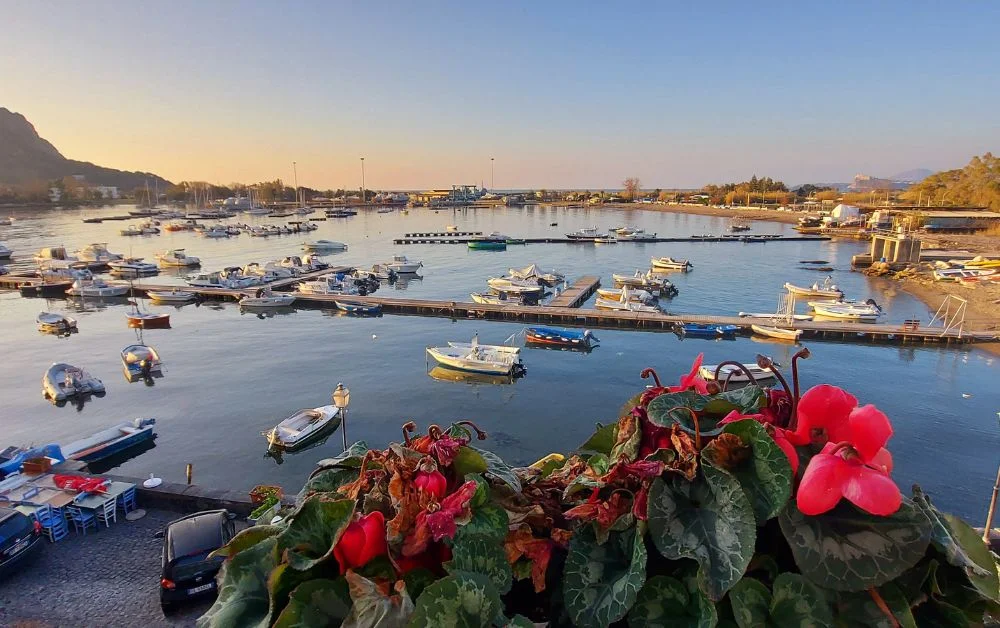
This content is not shown . Click on this block to display all our content, by accepting our cookies or review our cooky-policy below.
Let’s start from the southernmost tip of the Campi Flegrei: Miseno, and then go up through the coast toward Naples. See the map below.
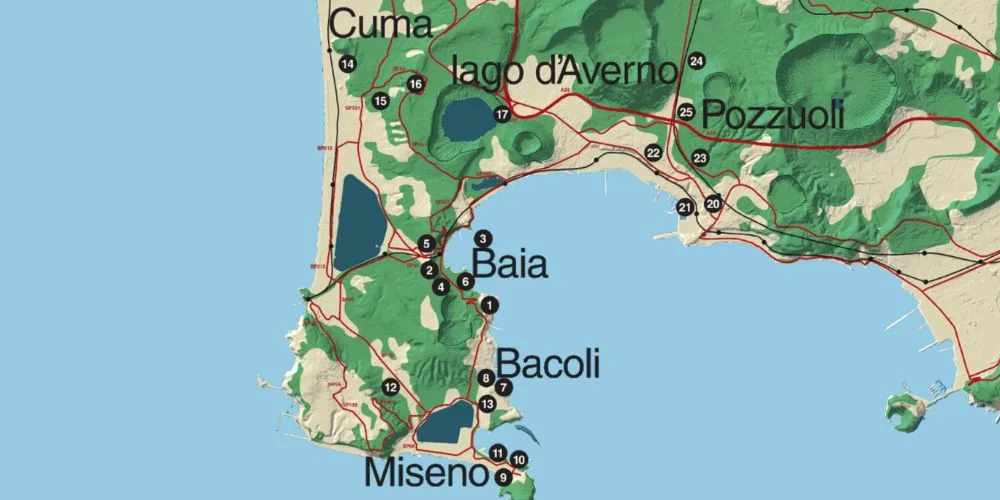
Piscina Mirabilis (Miseno)
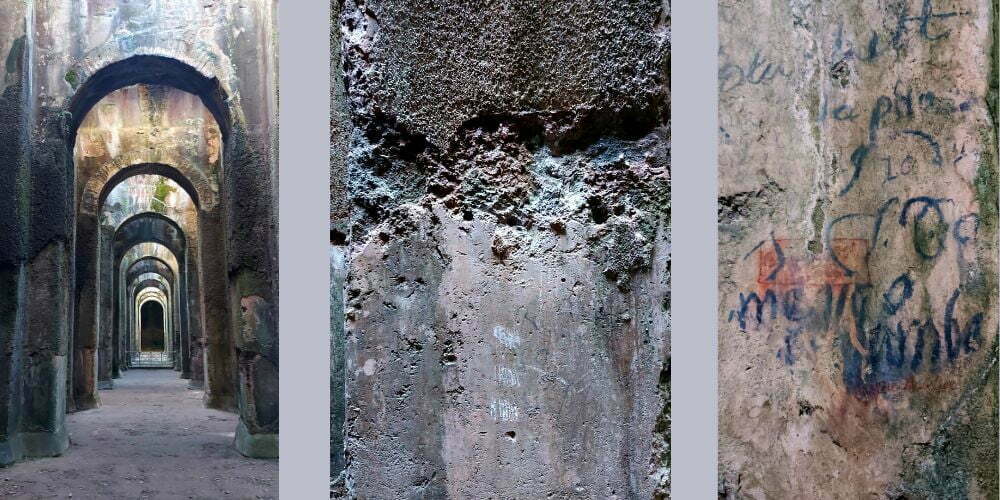
- Location: Miseno (part of the municipality of Bacoli)
- Why to see: Under ground cistern once provided water for Roman fleet + remains of waterproofing material + centuries-old visitors graffiti
- Genre: Roman
- How to visit: Only on Fri, Sat and Sun. Tickets at Via Campi Elisi 1 in Bacoli (300 meters from the ‘Piscina’-site)
The Romans were masters of water management, and acqueducts and fresh water storage fundamental to the running of the empire. Cisterns are found everywhere in the former Roman world, for example in today’s Istanbul and Tunis, however, Miceno’s cisterns are unique because of their size and the fact that they are completely intact.
As you descend an iron staircase, the magnificence of the complex meets you step by step. The cistern -entirely excavated in the tuff of a hill- is rectangular in plan: 70 meters long x 25 meters wide and 15 meters high, with a capacity of more than 12,000 cubic meters.
It is topped by a barrel-vaulted ceiling, supported by 48 cruciform-section pillars, arranged in four rows of 12. The wall structure is made of opus reticulatum (rectangular tuff tiles on a subsurface of concrete) and, like the pillars, is covered with waterproofing material.
The piscina mirabilis formed the terminal reservoir of an aqueduct, which carried water from springs 100 kilometers away. The water fed several towns along the way and reached Miseno. Once there, the water was meant for the troops of the Romans’ Western fleet, which had its base at Micenum (Miseno).
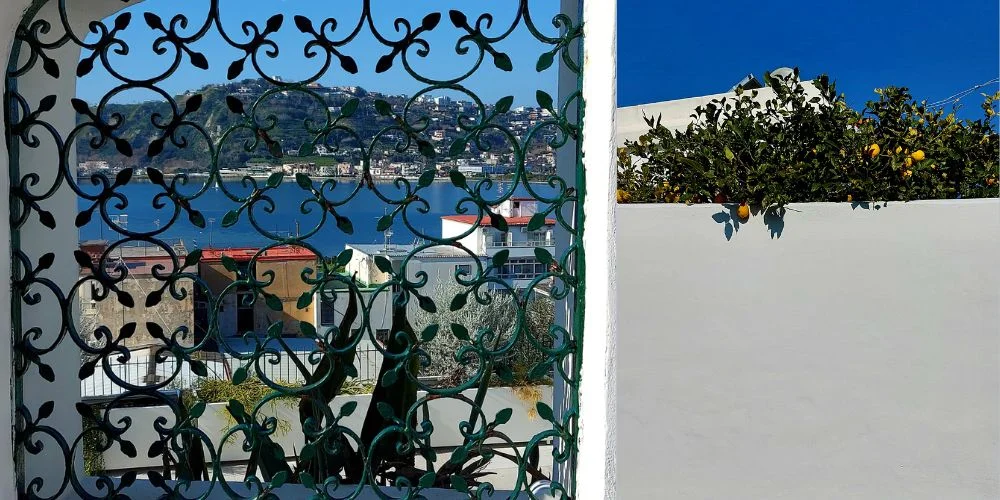
The harbor exploited a double natural basin, the innermost one of about 3 km circumference (called today Lake Miseno), in ancient times dedicated to shipyards and ship maintenance, and the outer one where the fleet with some 250 ships was anchored.
The commander of the fleet in 79 AD was Pliny the Elder. Seeing a strange cloud over Vesuvius on August 24 that year, he decided to sail across the bay to see what was going on. He would never return; the eruption of the Vesuvius had struck him too.
Sacello degli Augustali (Miseno)
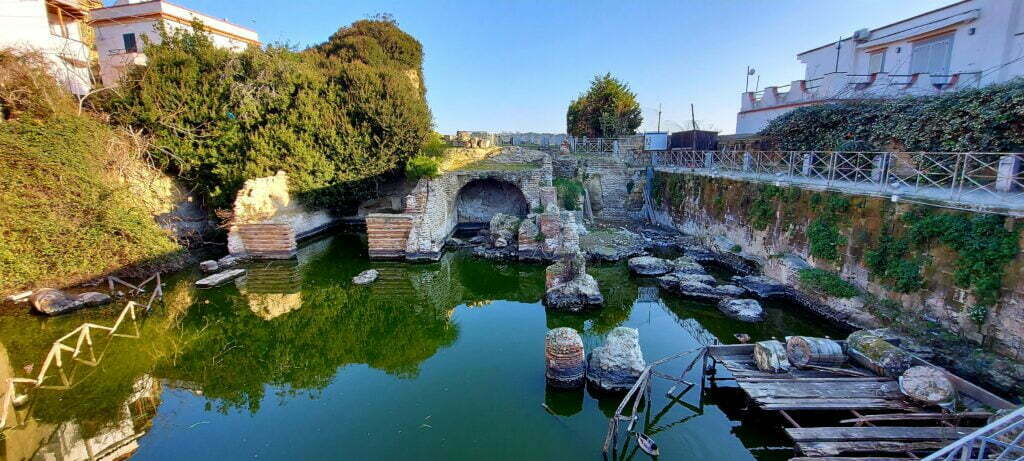
- Location: Miseno (Bacoli)
- Why to see: three 2000-year-old spaces standing in deep groundwater surrounded by modern day buildings
- How to visit: Seen from behind a gate on Via Sacello degli Augustali 4 (Bacoli). Currently (but for a long time…) not accessible
The building is dedicated to the worship of the emperor Augustus and made of masonry with stucco facings. Later, perhaps due to an earthquake, the structures collapsed and were partly crushed by boulders dislodged from the ridge behind.
The monument consists of three vaulted, side-by-side rooms, only partly built and partly carved out of natural tuff. The central space represents the sacellum (small shrine). The room is occupied by a podium temple of rectangular plan accessed by a marble staircase framed by masonry podiums, covered with marble slabs, in front of which is the altar.
The complex was found during construction work in 1968. The recovery work, became immediately difficult due to the original floor collocated about 6 meters deeper than the modern one, completely flooded by groundwater.
Grotta della Dragonara
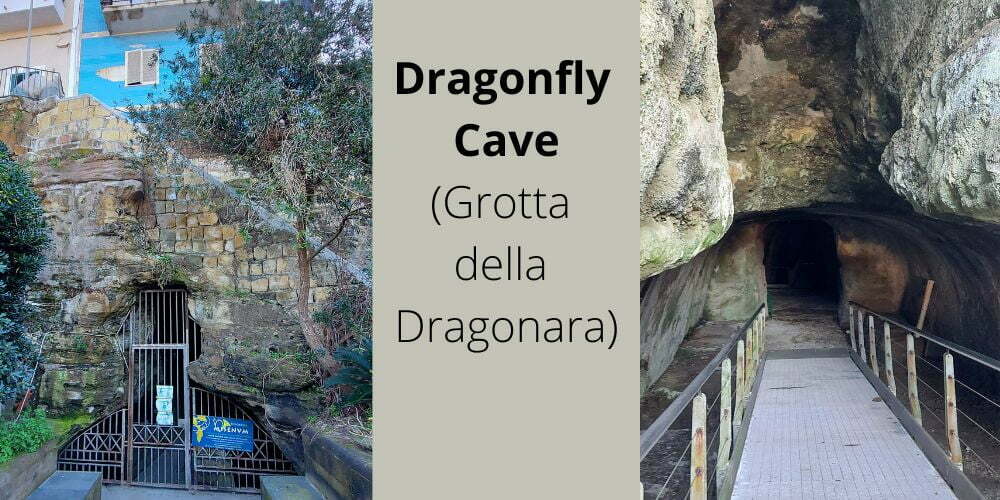
Not far from the Augustali and near a fine beach is the so-called Dragonfly Cave, which in reality was (also) a cistern. Opening hours are complicated and I have never been able to get in. Info at the cultural association Misenvm .
Bacoli Harbour
- Location: Bacoli
- Why to see: Lovely small mussel fishing port + supposed last resting place of emperor Nero’s mother
- Genre: Roman + Daily life
- How to visit: ‘Tomb of Agrippina’: Via Ortenzio 39 in Bacoli (right at the shore)
Bacoli has a small harbor where the so-called Tomb of Agrippina is also located.
Agrippina was the unscrupulous mother of Emperor Nero, who did everything she could to have her son become emperor. But once he was in power, she was killed at the behest of her own son, Nero. Her tomb is said to be here in Bacoli. The structure in reality was originally a theater ( odeion ) dating from the 1st century AD, that was attached to an ancient maritime villa.
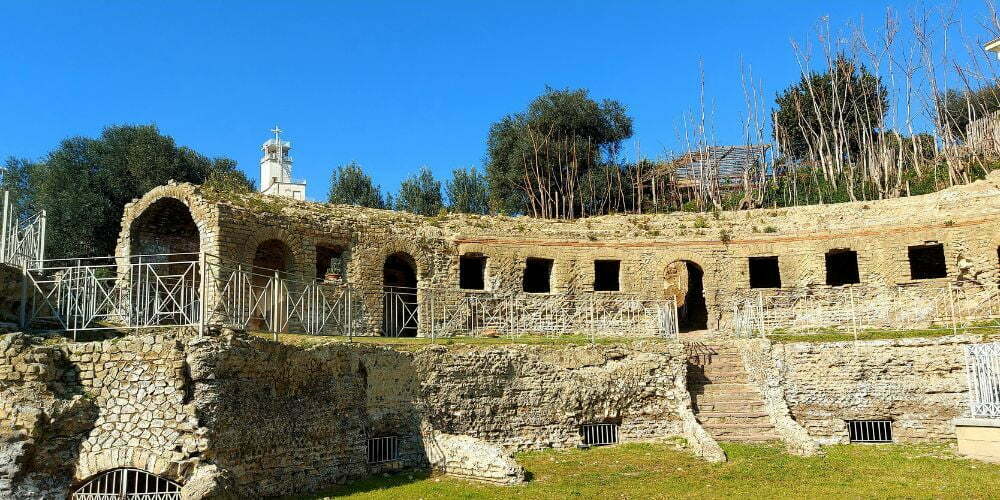
Bacoli features lovely small beaches with superb clear seawater. But if you think Bacoli lives only on tourism, see how the mussel fishermen are busily working. They don’t have to go far. From the shore you can see that about a kilometer away underwater mussel farms are located.
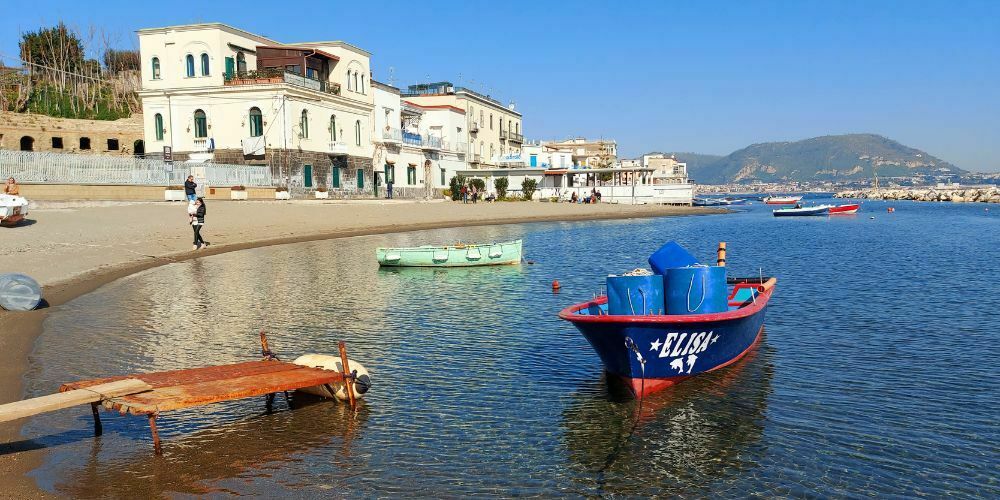
Archeological Museum of the Phlegraean Fields (Castle of Baia)
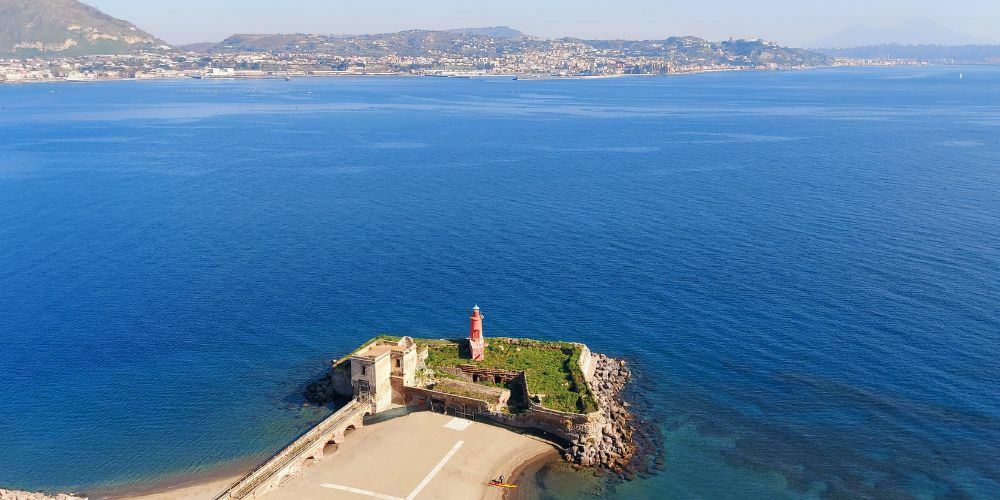
- Location: Baia (Bacoli)
- Why to see: magnificent views over the gulf of Pozzuoli + nice Roman artefacts
- Genre: Roman + Medieval
- How to visit: Via Castello 39 in Bacoli (Mondays closed)
The Castle of Baia, built between 1490 and 1493 by the Aragonese and enlarged between the 1500s and 1700s during the Spanish Viceroyalty, dominates the summit of the promontory that closes the Gulf of Baia to the south. It currently houses the Archaeological Museum of the Phlegraean Fields.

Well castles are usually grand, but this castle, because of its elevated position by the sea, is especially impressive. You can see it from everywhere (Miseno, Pozzuolo, Monte di Procida).
The rather small museum has interesting works from the Roman period. Not directly huge sculptures (for that you can better visit the Archaeological Museum in Naples), but a number of extraordinary works, such as a relief of a trireme , a three row ship. Imagine moving 2000 years in time and you could see such a ship passing right under the castle (if only the castle wasn’t there back then).
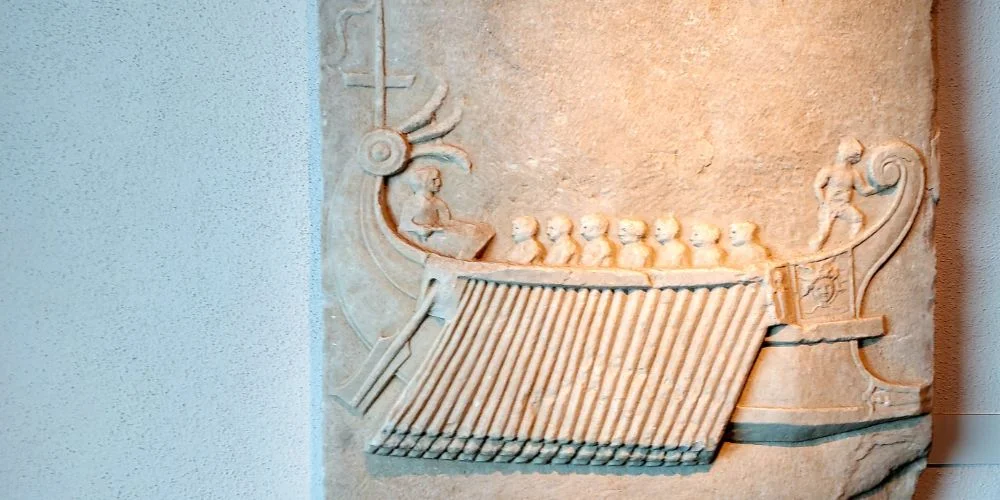
Archaeological Park of the Baths of Baia
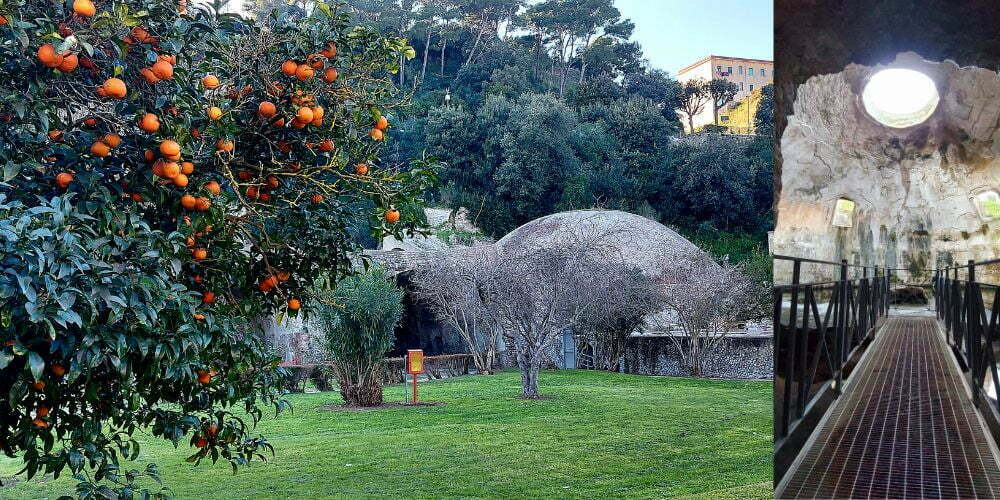
- Why to see: large archeo park + Pantheon-like structure
- How to visit: Via Sella di Baia, 22 in Baia (Bacoli) (Mondays closed)
What is now the archaeological park was once three private estates, each with its own thermal complex. There is actually not much left of the villa, although some interesting ornaments can be seen, such as a black-and-white mosaic and some fresco remains.
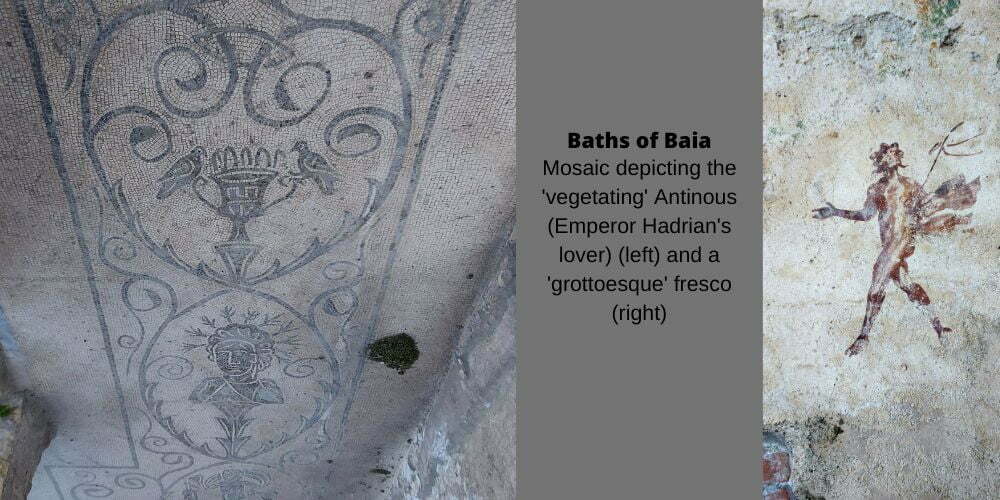
Really special are the dome structures, which are called temples, but were actually part of the thermal complexes. Most impressive is the Temple of Mercury, simply a Pantheon, like the one in Rome (okay, a bit smaller in size).
Part of villa structures is located on the seabed. The remains, including statues and colourful mosaics can be seen if you go on a diving or snorkelling expedition. You can also join a boat tour that has a transparent floor to see the underwater villa remains.
Vanvitelli's Hunting house (Casina Vanvitelliana)
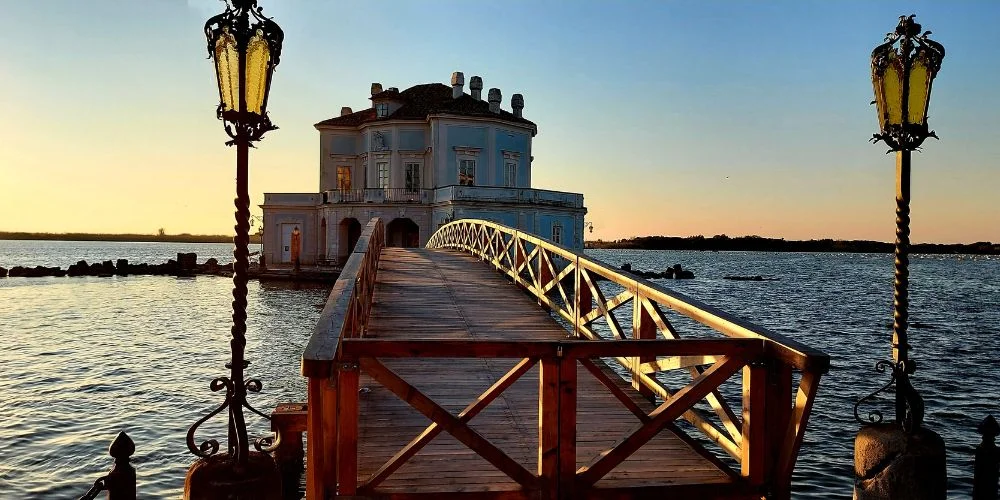
- Why to see: Nice lake house + sunsets
- Genre: 18th Century
- How to visit: Piazza Gioachino Rossini 1 in Bacoli (Fri-Sun only)
This splendid jewel of late Baroque architecture was built in 1782 on commission of Ferdinand IV of Bourbon (1751 – 1825), king of the Kingdom of Naples. The residence occupies a small emersion of land within Lake Fusaro and was used as a resting place after the king’s hunting and fishing trips.
The house is composed of three octagonal bodies intersecting one at the top of the other, narrowing into a sort of pagoda, with large windows arranged on two levels. The long wooden pier also connects the Casina to the lake shore and was used by illustrious guests, such as composer Gioachino Rossini.
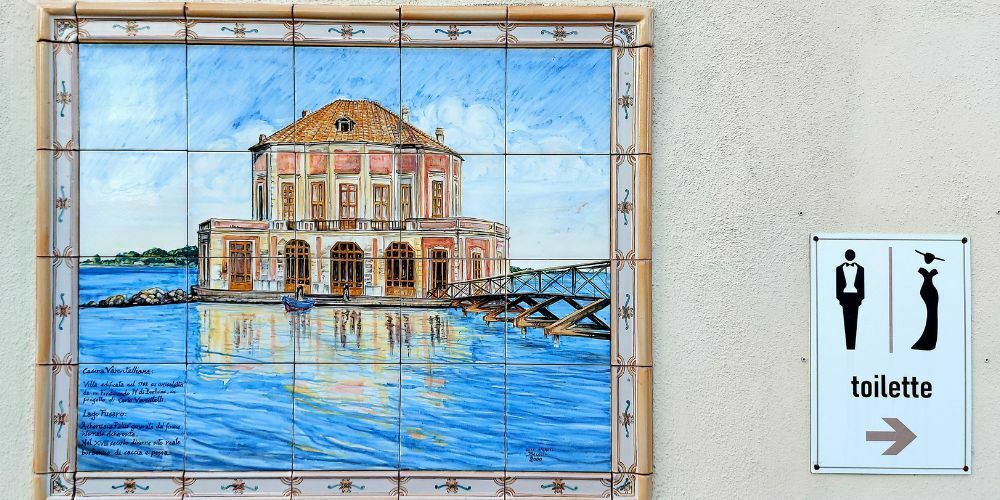
The architect is Carlo Vanvitelli (1739 – 1821), son of the famous Luigi (the author of the Royal Palace of Caserta), who in turn was the son of Gaspare Vanvitelli, the italianised name of Caspar van Wittel from Amersfoort. There is also always a Dutch link to everything…
Mythical Cuma
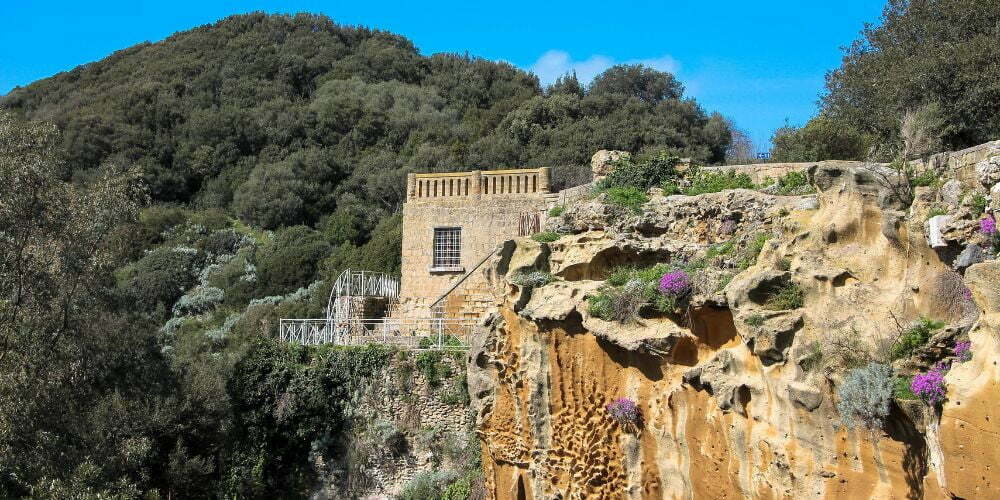
- Location: Cuma (Pozzuoli)
- Why to see: Ruins of one of the most mythical places in Roman times
- Genre: Greek/ Roman
- How to visit: Via Monte di Cuma 1 (Park), Pozzuoli (Tuesday’s closed)
Cuma has (to me) a mythical sound, or at least a mythological one.
The sibyl of Cuma or Cumae (Latin) was an oracle, and very important to the history of Rome. The Sibyl of Cumae is best known for the visit paid to her by Aeneas, according to the 6th book of Virgil’s Aeneid, to seek advice on his journey. The Sibyl, in the guise of an old woman, made her predictions in a cave near the temple of Apollo.
The Sibyl is also so famous because of Michelangelo’s painting, which depicted her so grandly on the ceiling of the Sistine Chapel in the Vatican.

Also read: Where to spot Michelangelo’s in Rome for free
It was long believed that the ‘Cave of the Sibyl’, a straight corridor (131 meter long and about 2.50 meter wide), was her ‘home, although it is now agreed that this was not the Sibyl’s cave, but what this corridor was for remains a mystery.
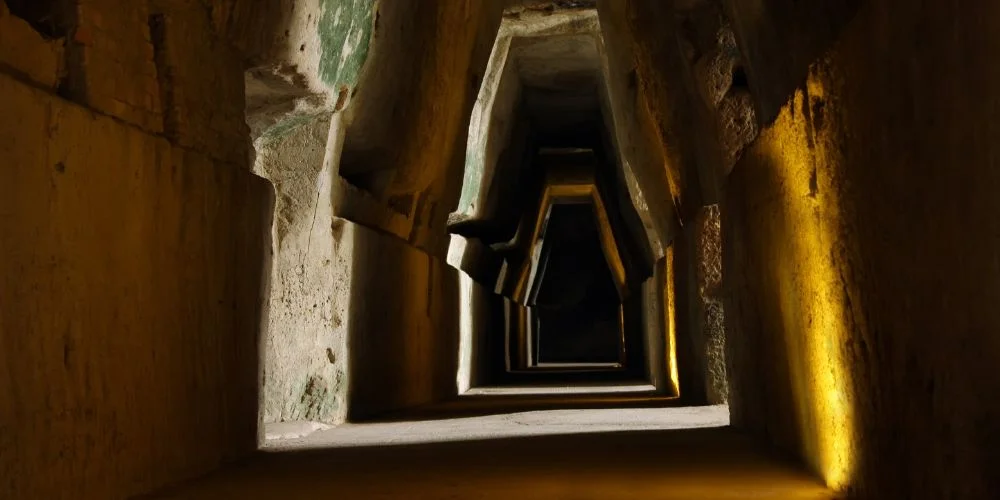
Either way, it is fascinating to visit the cave. Furthermore, the ancient city of Cuma, an original Greek colony (8th century BC), can also be visited. The ruins in the archaeological park, with the Acropolis, are a must.
Spa Baths of Agnano
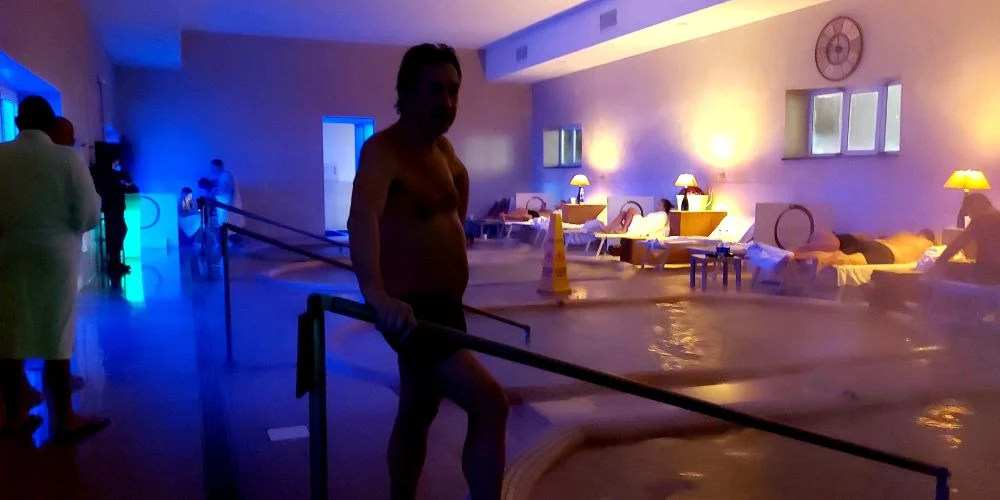
- Location: Agnano
- Why to see: Sulphur baths + do as the Romans did
- Genre: 19th Century/ modern
- How to visit: Via Agnano Astroni, City of Naples (Monday’s closed)
The Agnano valley in the Campi Flegrei are known as the widest thermal basin of Italy with 72 springs of different kinds. To my knowledge, only the Terme di Agnano , a commercial establishment, is now in use for ‘contemporary’ bathing.
Although 44 hectares in size, as they say themselves (probably including the large car park), it is nothing compared to the remains of the municipal baths, a majestic building, now in disrepair. These thermal baths experienced their period of greatest fortune, especially in the 1920s, so much so that they were considered a true ideal model of a thermal complex.
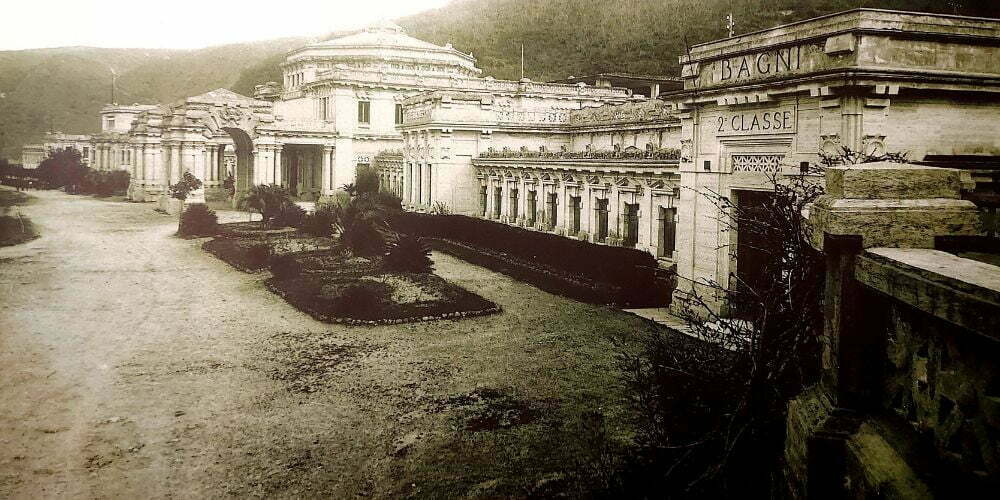
The Baths of Agnano of today stands pretty much on one of those 72 springs and flows out, in part sulphur water, into four indoor basins, each 2 degrees hotter than the previous one, and two large outdoor pools. There is a restaurant, where I ate surprisingly well and the servings were large. The fare was very okay: 60 euros for entrance tot the pools and dinner.
The Solfatara
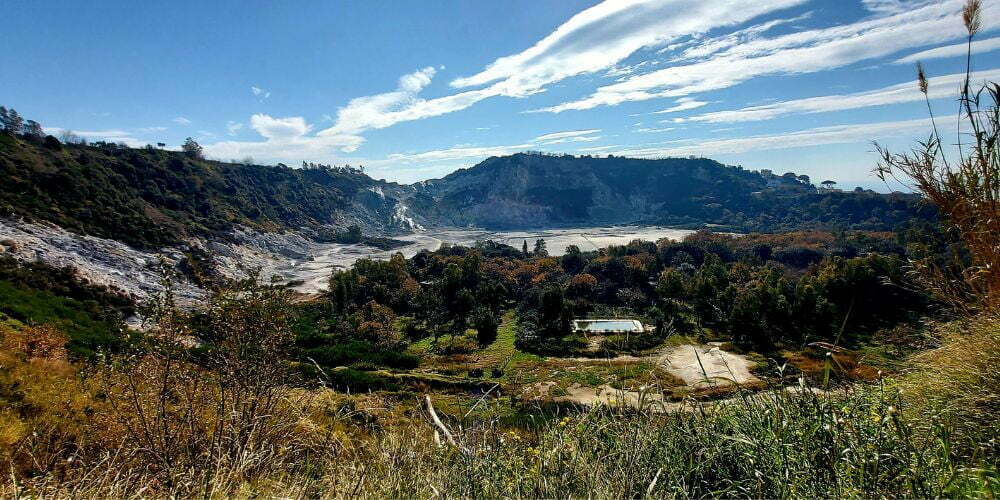
- Location: Pozzuoli
- Why to see: Vulcanic activity
- Genre: 2000 BC/ Roman/ modern
- How to visit: Via Solfatara, 161 in Pozzuoli (closed). Overview from the Via Coste D’Agnano
Solfatara is the name of the active volcano located just above Pozzuoli, the main city of the Phlegraean fields or Campi Flegrei. It is also the area’s name giver: the Burning Fields.
When you go there, you immediately notice the activity. Smoke curls up in a volcanic ‘pit’, the site has the colour of oxidised sulphur and the sulphur smell is unmistakable. It looks fascinating from a distance. What if the volcano really comes out of hibernation again?
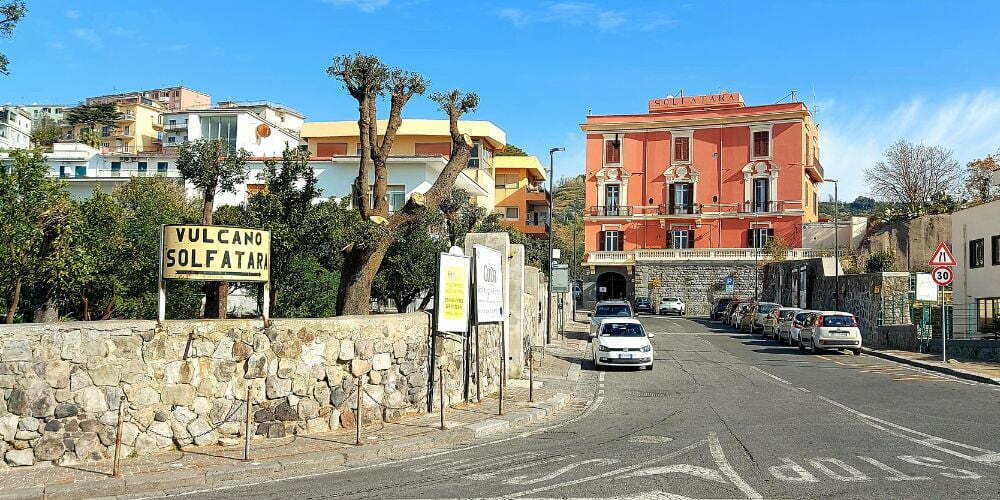
The name of burning fields is quite literal. In Italy, it rightly made headlines in the newspaper when in 2017 a family composed of three members died after falling into the boiling mud, into a three-metre-deep sinkhole. Since then, the solfarata is closed for visits.
Pozzuoli's Amphitheatre
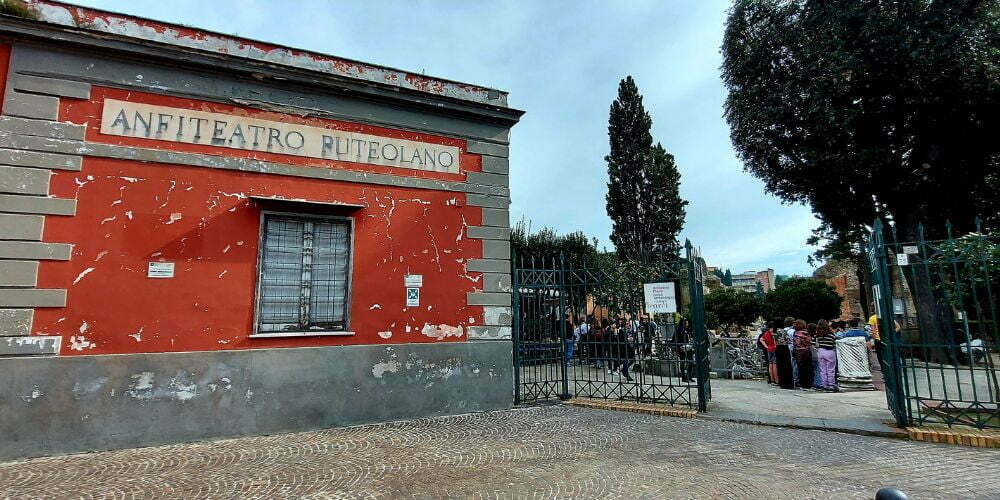
- Why to see: 3rd biggest Roman amphitheatre + impressive undergrounds
- How to visit: Corso Terracciano 75 in Pozzuoli (Tuesday’s closed)
After the Colosseum (Rome) and the amphitheatre of Capua, the amphitheatre of Pozzuoli is the third largest arena in Italy (149×116 m), and could seat up to 40,000 spectators. The layout, elliptical, was surrounded all around by a vaulted portico, with trachyte pillars completed by half-columns
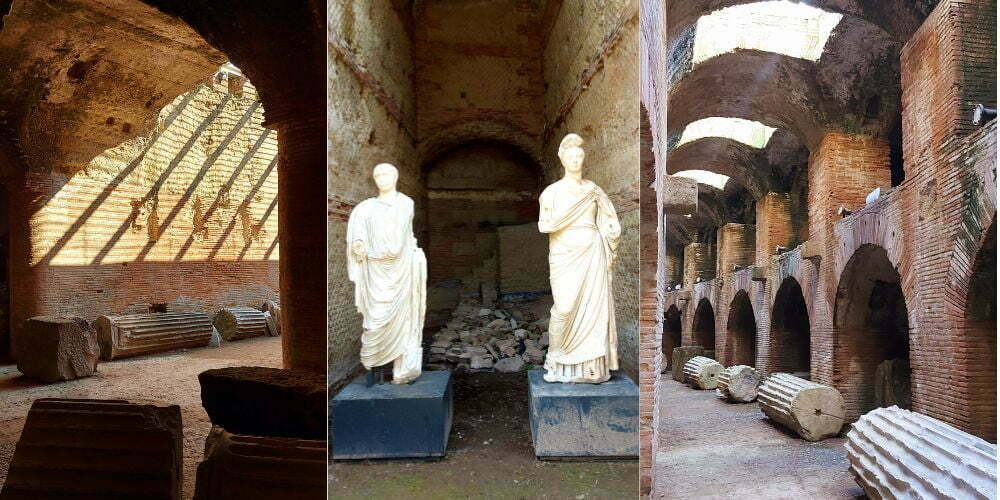
It is mainly because of the underground of the theatre, where once the props, slaves and animals were kept, that makes it a very interesting archaeological site. The structure stands as if no 2,000 years had passed with arches made of Roman brick. There is a lot of spoglia, especially parts of columns and capitals, which probably once stood on the outside. The stands have also stood the test of time reasonably well.
Quite nicely, the modern city of Pozzuoli has modelled itself around the amphitheatre. The theatre thus is not a mere relic of distant times.
City of Pozzuoli
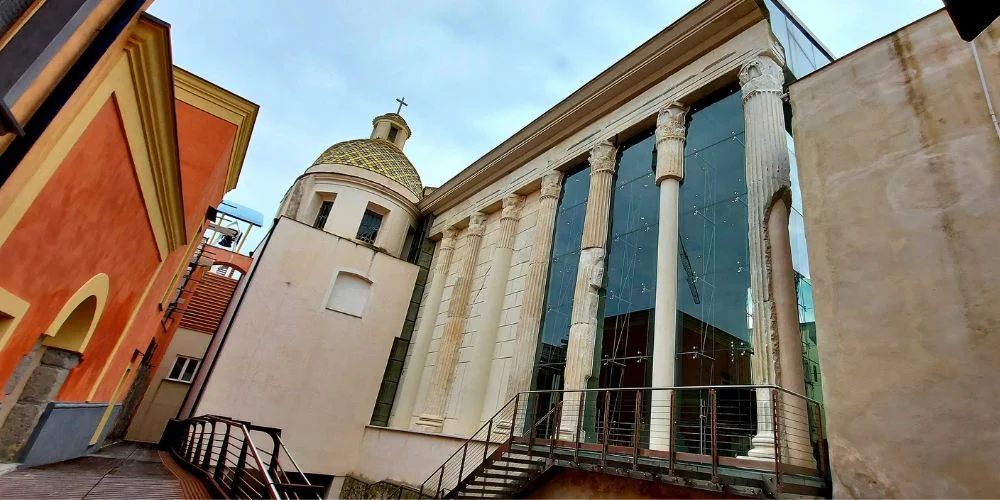
- Why to see: Roman ruins + Rione Terra
- Genre: Roman / medieval/ modern
- How to visit: Via Serapide 13 (‘Temple’ of Serapis) and Str. Duomo (infopoint Rione Terra)
Pozzuoli is famous from ancient times, but also (to me) as the birthplace of Sofia Loren. That aside, however.
The (impressive) remains of ancient Puteoli are completely surrounded by modern and quite ugly Pozzuoli. It is a crazy mix that also fascinates because it is also so detonating (with the exception of the area around the amphitheatre).
Near the modern port stands a huge ruin. The building was long incorrectly called the Temple of Serapis, due to the discovery of a statue of the Egyptian god at the time of the first excavations. Subsequent studies have instead ascertained that it is the ancient macellum or the public market of Roman Puteoli .
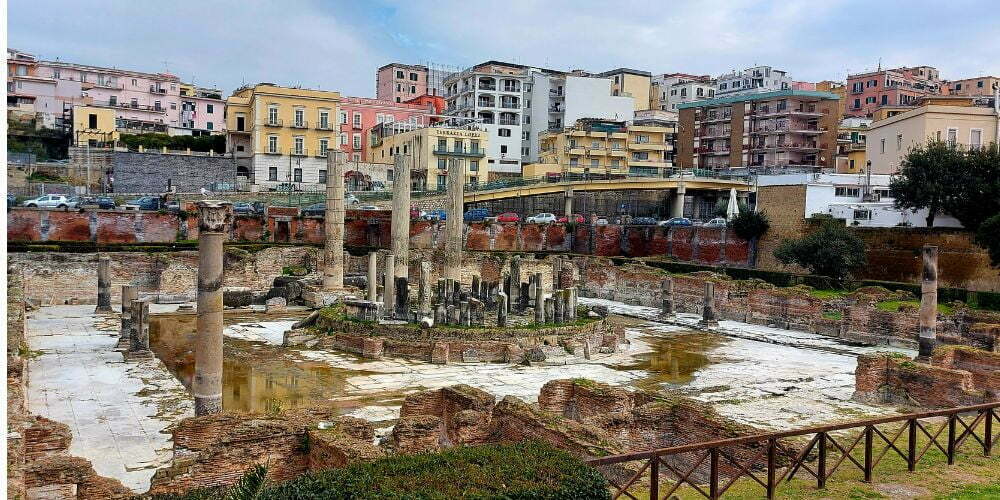
The ancient Roman city of Puteoli, founded in 194 BC, was built on a tuffaceous rock. Still part of that city can be visited underground. Carved into the tuffaceous rock there is a perfectly preserved archaeological trail that is called Rione Terra.
Above the underground, many of the houses as well as the Cathedral have been restored pretty picobello . But due to bureaucratic reasons, the beautifully pastel-coloured shops and houses are now empty. One day, Rione Terra should burst with conviviality and liveliness again.
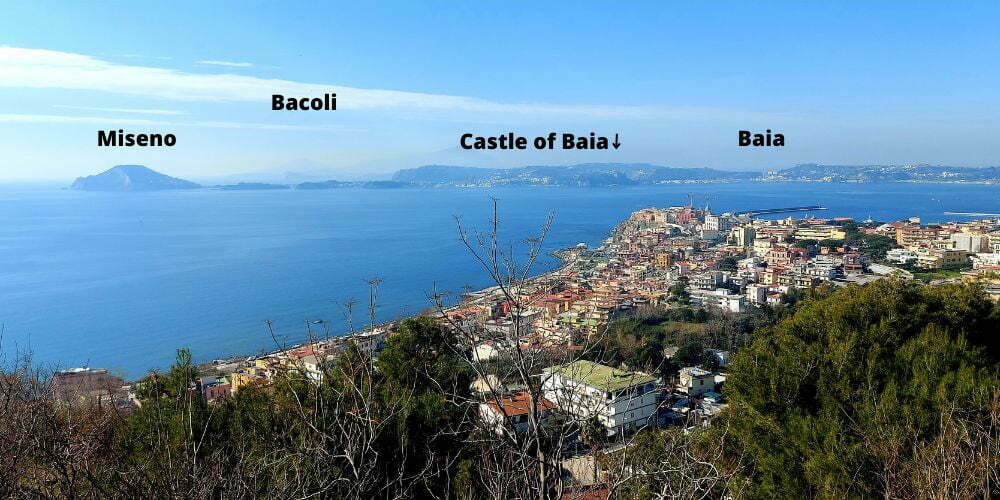
From Pozzuoli, from Rione Terra, or upwards (see photo) you have a great view over the Gulf of Pozzuoli with all the places we have visited.
- Villa Ludovisi auction: a peek into the expensive Rome villa
- How big is Italy? Size of the land, population & economy
- Facts about pizza: 20 interesting unknown pizza facts
- Italian movies on Netflix and Amazon: 24 best recommendations in 2022
Read more in :
What to do in Milan: visit Monza
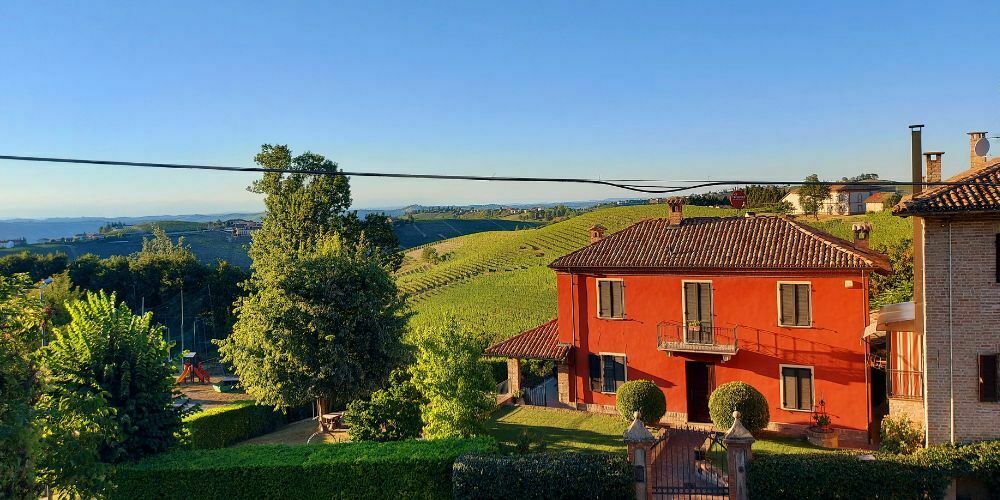
Langhe Italy: all about this wine region + 7 things to do
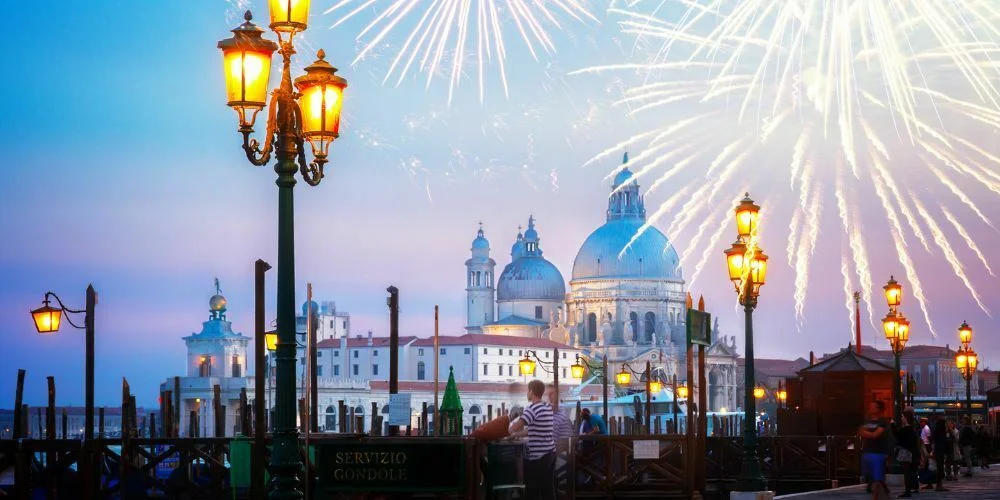
Italian New Year traditions: a guide with 8 typical habits
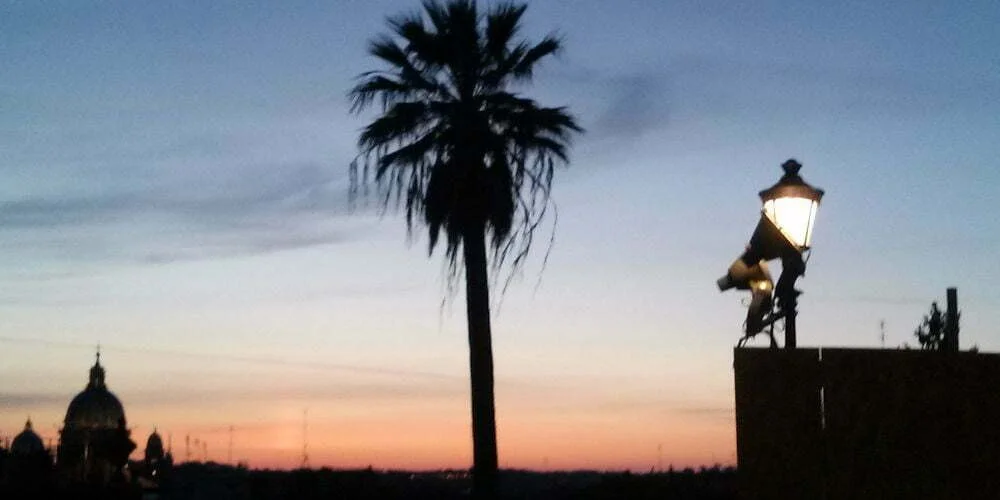
Italy in October: best places to visit and 7 tips
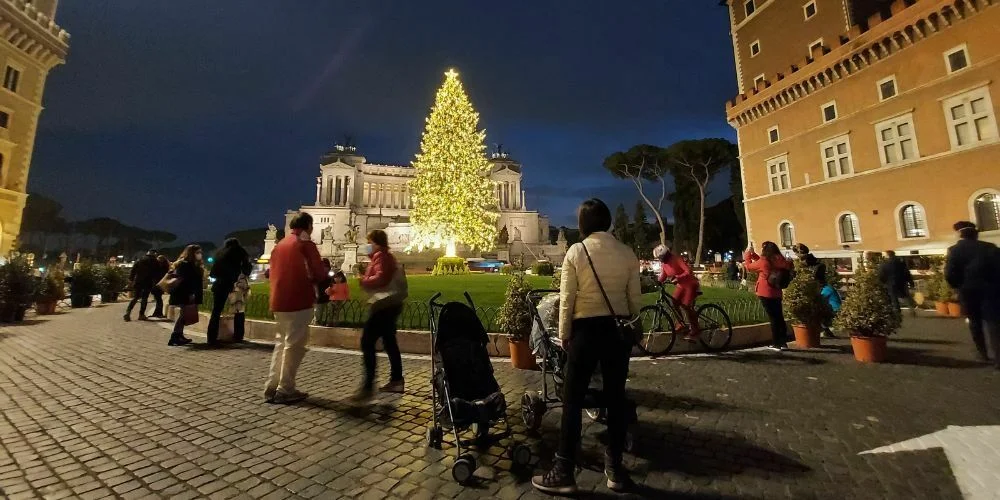
Italy in November: tips, weather, and 5 best places to visit
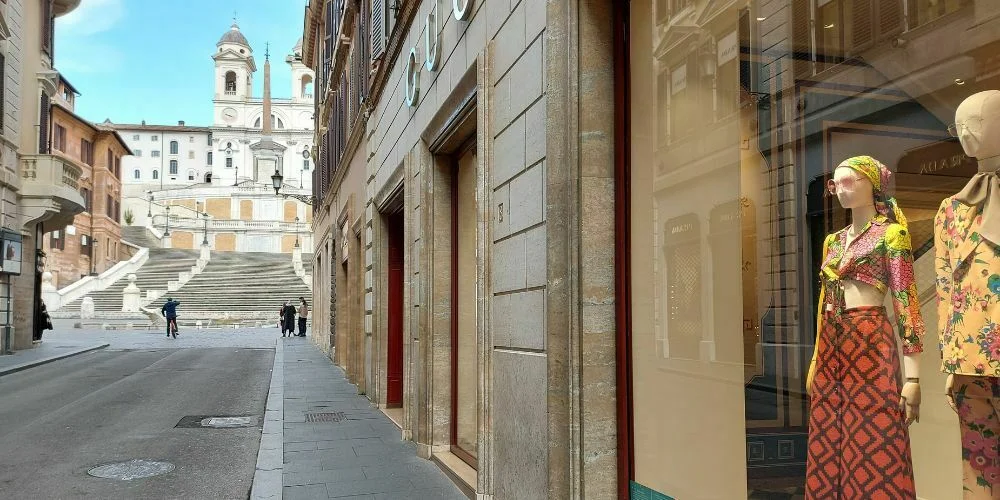
Italy in January: 7 useful tips and best places to visit
1 thought on “campi flegrei: 11 things to do at the phlegraean fields”, leave a comment cancel reply.
Our articles may contain ‘affiliate links’ that allow us to earn a small commission, at no extra cost to you – read more

About ItalyStart
Cookie Policy
To provide the best experiences, we and our partners use technologies like cookies to store and/or access device information. Consenting to these technologies will allow us and our partners to process personal data such as browsing behavior or unique IDs on this site and show (non-) personalized ads. Not consenting or withdrawing consent, may adversely affect certain features and functions.
Click below to consent to the above or make granular choices. Your choices will be applied to this site only. You can change your settings at any time, including withdrawing your consent, by using the toggles on the Cookie Policy, or by clicking on the manage consent button at the bottom of the screen.
Phlegraean Fields – What to see and why visit them?
The Phlegraean Fields represent a fascinating volcanic area located in the Campania region, in southern Italy. With its unique geological history, the breathtaking beauty of its landscapes and its important historical testimonies, the Phlegraean Fields are an ideal destination for lovers of nature and culture.

The term “Phlegraean Fields” derives from the Latin “Campi Phlegraei”, which means “fiery fields”. This name was given to the region due to its past volcanic activity and the numerous craters present in the area. The presence of volcanoes, fumaroles and thermal springs makes this area a place of great geological and scientific interest.
What to see in the Phlegraean Fields?
History and mythology of the phlegraean fields, the geological phenomenon of bradyseism.
The place offers a variety of breathtaking landscapes that capture the imagination. From the evocative volcanic calderas, such as Lake Averno and Lake Fusaro , to the green hills that extend to the coast, the area offers a unique mix of natural and volcanic elements. The panoramic view of the coast and the Gulf of Naples adds a touch of unparalleled beauty.
The Solfatara represents one of the main attractions of the area. This active volcano has a smoking crater and offers the opportunity to observe geothermal activity up close. The presence of fumaroles, boiling mud pools and thermal springs testifies to the underground energy that still permeates the region. Places such as the Solfatara and the Astroni Volcano offer the opportunity to explore these phenomena up close and understand the power of nature.
The region is rich in archaeological sites of great historical and cultural importance. One of the most famous is the Archaeological Park of Cuma , one of the oldest Greek colonies in Italy, with its Temple of Apollo and the Sibyl’s Cave. Other sites of interest include the Casina Vanvitelliana in Bacoli and the Flavian Amphitheater in Pozzuoli. The latter, often called the “little Colosseum” due to its resemblance to the amphitheater of Rome, is an ancient Roman amphitheater that could accommodate up to 20,000 spectators. It is an impressive place to visit to admire the well-preserved Roman architecture.

Another place that is definitely worth a visit is Baia . This important Roman city is known for the luxury villas built along the coast. Some of these villas are now submerged due to rising sea levels, offering a unique scuba diving opportunity to explore the remains of ancient grandeur.
Vulcan, the Roman god of fire and metallurgy, occupies a prominent place in the mythology of the Phlegraean Fields. His forging of weapons and precious objects was believed to occur within the region’s volcanoes, such as the Solfatara. The continued volcanic activity of the area was explained as the incandescent work of Vulcan.
The hot springs in the area were considered sacred to Apollo, the Greek god of healing and the arts. Baia was home to a famous temple of Apollo, known for its healing hot springs. People came here to seek healing from illnesses and to relax in the warm waters. Cuma was home to the famous oracle of Apollo, where priests held uncomfortable prophecies. The Cumaean Sibyl , the priestess of the oracle, is believed to have inspired many legends about the ability to predict the future.
Finally, the Phlegraean Fields were associated with the Roman underworld (the Elysian Fields ). The entrance to the afterlife was believed to be located in this region, with Lake Avernus serving as the gateway to the world of the dead. This belief has been immortalized in the works of authors such as Virgil, who described the Roman afterlife in his epic poem, the Aeneid.
Typical of the area is the phenomenon of subsidence (lowering of the ground) called Bradyseism . This phenomenon is caused by the movements of the underlying magma chambers, which expand and contract in response to volcanic processes. The volcanic activity of the Phlegraean Fields can generate an increase in pressure inside the magma chambers, which in turn causes deformations of the ground.
To fully understand bradyseism in the Phlegraean Fields, it is necessary to take a journey into geological history. This region has been shaped by millennia of volcanic activity and is home to famous volcanoes such as Monte Nuovo, Solfatara and the infamous supervolcano, Monte Epomeo.
The term “bradyseism” comes from ancient Greek and means “slow movement”. And that’s exactly what happens here. Over the centuries, the soil of the Phlegraean Fields has risen and lowered in an apparently random way. This movement is often induced by underground volcanic activities and the buildup of heat and pressure. Bradyseism can be fast or slow, but either way, it is an essential part of life in this region.
Constant studies and monitoring are underway to better understand bradyseism in the Phlegraean Fields. This region is still active and subject to volcanic eruptions. Its geological history and the mysteries of bradyseism are a constant reminder of the power of nature. The beauty of the Phlegraean Fields is constantly evolving, making this place an extraordinary destination for lovers of geology, ecology and natural beauty.
Scientists have identified two key phases in the bradyseism cycle: inflation and deflation. During the inflation phase, the ground slowly rises. Then, during the deflation phase, the ground gradually returns to its original level. This cycle continues in a seemingly unpredictable way and can cause significant environmental changes such as the lowering of some land below sea level and resulting coastal flooding.
In summary, the Campi Flegrei are a fascinating destination for anyone interested in geology, nature and ancient history. The region offers a unique experience that mixes past and present in a context of extraordinary natural beauty.
- Amalfi Coast
- Pompeii - Mt. Vesuvius
The Phlegraean Fields
A legendary spot of fire and water
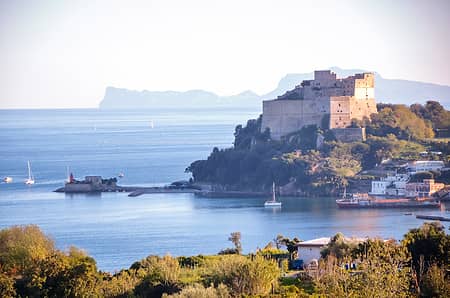
The Italian name Campi Flegrei can be translated as "The Fiery Fields", and it is a fitting moniker for this stretch of coastline west of Naples that lies above the the largest volcanic area in Europe. This fascinating area is home to a number of important archaeological sites, coastal lakes, beaches, thermal springs, and nature reserves and is worth a day trip from the bustling capital city of Campania.
The Best Time to Visit the Phlegraean Fields (Campi Flegrei)
If you are planning an excursion to the Phlegraean Fields, we suggest visiting in spring or autumn . In addition to avoiding the high-season crowds and prices, the mild weather in these shoulder seasons makes for a much more pleasant visit; remember that much of the Campi Flegrei are active thermal and volcanic areas, so can be uncomfortably hot in the summer months. In the winter, many restaurants and other businesses close for the season.
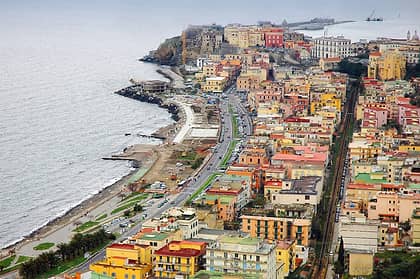
Getting to the Phlegraean Fields from Naples
The Phlegraean Fields are only about 40 minutes from the center of Naples , and can be reached by public transportation via the Ferrovia Cumana rail line that departs from a number of stations in central Naples, including Montesanto in the historic center and Corso Vittorio Emanuele in the Mergellina and Fuorigrotta neighborhoods. The Cumana stops in a number of locations in the Flegreaen area, including Agnano, Pozzuoli, Lucrino, and Lake Fusaro.
You can also take metro line 2 that runs between Agnano and Pozzuoli.
The Phlegraean Fields by Car It's easy and convenient to take in the top sights in the Phlegraean Fields by car, especially if you are visiting outside of the crowded high season. In summer, we do not suggest trying to get around by car on the weekends, as traffic can be very heavy. Keep in mind that you must also buy a pass and pay for parking to access the most popular beaches in the Phlegraean area in the summer months.
What to See in the Phlegreaen Fields
The Phlegraean area is rich in historic, cultural, and natural sights and you will need at least two or three days to admire them all; we suggest booking a hotel in the area to avoid wasting time on transportation.
Depending upon the amount of time you have and what your interests are, you can decide to pick and choose the sights to visit, even limiting your time to a day trip or half-day excursion.
Pozzuoli is the most important town in the Campi Flegrei, well-connected to Naples and located just 20 kilometers from the city center. This pretty seaside town has ancient roots and is set along the gulf of the same name.
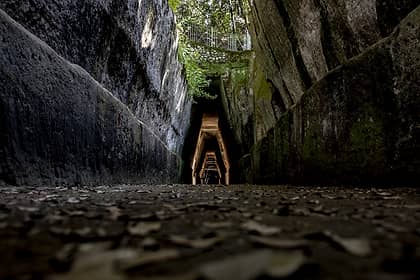
In Pozzuoli, you can visit a number of ancient Greco-Roman sites , including the Flavian Amphitheater (the fourth largest in Italy) and the Temple of Serapis, an ancient Roman open-air market.
A Trip to Inferno If you are planning on visiting Pozzuoli, be sure to stop at the Averno Lake , a small lake set inside an extinct volcano located between the towns of Cuma and Lucrino near the coast. Lined by a number of archaeological sites, the lake is famous for being named by the Roman poet Virgil as the entrance to hell in his epic Latin poem "The Aeneid".
You can also visit the Oracle of the Cumaean Sibyl , the priestess that presided over the Apollonian oracle at Cumae, an ancient Greek colony that was once located in the Phlegreaen Fields. The cave where the sibyl pronounced her prophesies is known as the Antro della Sibilla , and is located in the modern city of Pozzuoli where Cumae once stood.
The Pozzuoli port is a popular and convenient jumping off spot to visit the islands of Ischia and Procida .
The town of Baia, part of the larger municipality of Bacoli, is another must-see in the Campi Flegrei due to its ancient treasures. Don't miss the Piscina Mirabilis , an impressively immense Roman cistern, and the Castello Aragonese set in a strategic spot overlooking the sea and home to an interesting archaeological museum. Near Baia's castle, you can also relax on the small beach to break up your day of touring.
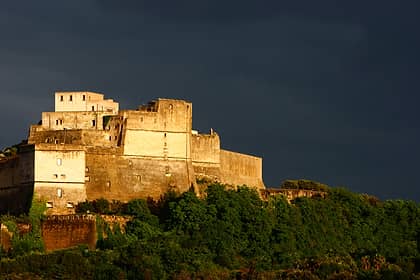
Visiting Baia's Castello Aragonese Address: Via Castello 39, Bacoli (Naples) Hours: 9AM to 2:30PM, last entrance at 1:30PM. Closed Mondays. Admission: EUR 4
Another highlight of Baia and the entire Phlegraean Fields is the Underwater Archaeological Park , home to the remains of the ancient city of Baia. Admire statuary, amphorae, remains of buildings, and other ancient artifacts hidden beneath the waters of the Mediterranean.
A Glass-Bottomed Boat To take in the treasures of the Underwater City of Baia, join a guided tour on board a boat with a transparent bottom that provides a unique window into the underwater ruins and a chance to travel backwards in time. If you are a diver or snorkeler, you can explore the ruins up close by taking a diving excursion into the ruins, one of the most unique experiences in the Phlegraean Fields.
Lake Fusaro
Near the town of Baia outside Bacoli, stop to visit Lago Fusaro , a coastal lake mentioned in "The Count of Montecristo" by Alexandre Dumas. In the center of Lake Fusaro and connected to the shore via a wooden bridge, the 18th-century Casina Vanvitelliana hunting lodge was designed by the famed architect Vanvitelli for the Bourbon King Ferdinando IV .

The Cratere degli Astroni Nature Reserve
If you love hiking and outdoor sports, the Phlegraean Fields is ideal for experiencing the great outdoors on foot. Visit the WWF Cratere degli Astroni Nature Reserve that covers roughly 250 hectares, including three lakes and a number of forested hills, to take in the variety of native flora and fauna; the reserve offers guided tours that must be booked in advance.
Visiting the Cratere degli Astroni Nature Reserve Address: Via Agnano Astroni 468, Naples Winter Hours: 10AM to 5PM; last entrance 3PM Summer hours: 10AM to 6PM; last entrance 4PM Admission: EUR 6
Beaches in the Phlegreaen Fields
The Phlegreaen Fields are the perfect destination for those who want to pair cultural sites with a stop at the beach . Most of the beaches in this area are volcanic, with dark sand or pebbles. Their volcanic nature also means that the water is not always crystalline, especially in the crowded months of July and August. Be prepared for heavy traffic and long waits to enter the parking areas in the summer; we suggest avoiding visiting on the weekend.

The most beautiful beaches in the Phlegreaen Filds are Miliscola, the beach next to the Baia castle (accessible only by boat), and the Romana di Bacoli and Insenatura dello Schiacchetiello beaches, both in Bacoli.
A Private Island For a unique day at the beach, visit the islet of San Martino , a tiny island that detached itself from Monte di Procida during an earthquake in 1488. The island is private property, but can be reached via the 3-kilometer toll tunnel from Cappella, halfway between Monte di Procida and Bacoli.
Most of the coastline in the Phlegreaen Fields has both free, public beaches and private beach clubs which rent sun beds and umbrellas by the day.
Visiting the Hot Springs in the Phlegreaen Fields
Due to their volcanic origins, the Campi Flegrei are rich with thermal springs where locals and visitors alike have gathered to soak in the therapeutic waters for hundreds of years.

If you love hot springs, we suggest that you set aside at least a few hours to relax in the thermal baths located in the Phlegreaen Fields. The Stufe di Nerone in Baia are located on the spot where ancient Romans once gathered to "take the waters" and include pools and baths in a variety of temperatures, thermal mud baths, and two natural saunas located inside small grottoes where the temperature reaches 53°C. The spa here also offers a restaurant and a variety of therapeutic massages.
Alternatively, visit the historic Terme di Agnano which offers a variety of thermal pools and a spa with massages and treatments.

- Things to do in Naples
The Best Experieces All Around Naples
Typical products, Fashion, Souvenir...
Museums, Castles, Archaeological Sites...
Pizzerias, Restaurants, Street Food, Bakeries...
Visit the places of Naples for free
Discover the wonders of Naples
Wellness, Where to drink, Fun...
- Choose your accommodation
Best Bed & Breakfasts in Naples
Best hotels in Naples
Best vacation rentals in Naples
Best Hostels in Naples
Discounts at the best facilities in Naples
- Naples Pass

Discounts, museums and public transport in Naples
- Tips for visiting Naples
Info, luggage storage, maps, useful numbers...
Visit Naples in autonomy
Travel for free throughout Campania
Where to park your car in Naples
- Visit Naples

Traveller guide for the city of Naples
- Attractions
- Napoletanity
Accedi gratis alle principali attrazioni di Napoli ed ottieni sconti nelle migliori attività

- Ingresso gratuito alle principali attrazioni di Napoli
- Trasporti pubblici gratis per tutta la Campania
- Sconti nei migliori Hotel, Ristoranti e Attività commerciali
The Phlegraean Fields: let's find out the four elements of nature in these magical places!

The Greeks called the western area of Naples “Phlegraean Fields”: the area goes from Posillipo to Cuma and includes Pozzuoli, Bacoli, Monte di Procida and Quarto, and also the islands of Nisida, Procida, Vivara and Ischia. This area is characterized by fumaroles, thermal waters, extinct volcanoes and lakes. The Phlegraean Fields (from the Greek “flegraios”, meaning “fiery”) are the place where the four elements of nature – fire, water, earth and air – coexist in perfect harmony. The presence of those four elements is also found in the myth and in the legends about these places, as evidenced also by the great poems of Omero And Virgil . If you want to have a tour in these fascinating and suggestive places , you can rely on “ La Terra dei Miti ” company that gives you the opportunity to find out the beauty of Phlegraean Fields and to live a memorable experience. So, let's find out some of these magical places together!
Lago d'Averno

The Lago d'Averno (Avernus Lake) is located in a basin between Lucrino and Cuma. It is located in the crater of an extinct volcano , dating back 4.000 years. The lake is surrounded by thick vegetation : there are vineyards, maritime pines, willows, brooms and woods. The air element already appears in the tradition. In fact, it is said that carbonic acid fumes and gases of the water would have excluded any form of bird life: the term “Averno” comes from the Greek “aornos” (meaning “without birds”). Instead, many bird species currently inhabite this area. There are also water and fire in the myth : according to the ancient Greeks and Romans, across the lake you accessed to the so-called Underworld. In the poem “Eneide” the famous poet Virgil describes this place as “ingresso agli inferi” and Enea (the main character of the poem) will cross this area. In Roman times, upon Emperor Augusto's request, the politician and architect Agrippa built a port complex near the lake: it's called “Portus Julius” . Across the lake there are also the ruins of the “Tempio di Apollo” : a majestic termal spa of Roman origin.
Terme di Baia
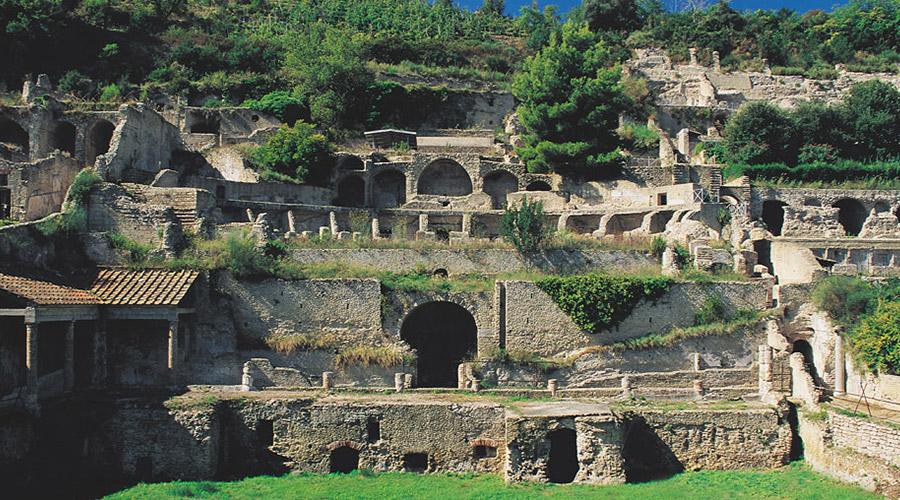
Baia (in ancient times, “Baiae”), is where there were very therapeutic thermal waters . Baia was the retreat holiday of the Roman aristocracy: there were thermal baths, leisure facilities, libraries, gyms and gardens, according to the latin principle “mens sana in corpore sano” (“a healthy mind in a healthy body”). In this place, the natural elements water and earth combine : the “ bradisismo” (in the 3 rd and 5 th century AD) caused a lowering of the soil and consequently many buildings collapsed below sea level and formed an underwater park of great historical and natural value. The Baia Archaeological Park extends for 40.000 square metres and hosts the ruins of these buildings: spa and ancient Patrician's residences. The Park is divided into sections (Villa dell'Ambulatio, Terme di Mercurio, Terme della Sosandra, Terme di Diana and Terme di Venere).
Piscina Mirabilis

The “Piscina Mirabilis” is the largest Roman water cistern. It was built during Augustus age: it is carved into the tuff and it is covered with a vault supported by many pillars that form five naves. In ancient age, the cistern supplied the imperial Roman fleet docked at the port of Miseno. The water came from Serino (in the Avellino area), traveled 100 kilometres (supplying Naples and the Phlegraean Fields) and finally arrived in Miseno. This ancient structure is now a “temple of water” : a very suggestive archaeological site of great beauty.
Antro della Sibilla

The Antro della Sibilla (Sibyl's Cave) is located near the Avernus Lake and it's the most famous site of the ancient Cuma. The cave was carved into the tuff during the Augustus age and it consists of a trapezoidal corridor over 130 meters long with side openings, from which air and natural light entered. At the end of the corridor there is a rectangular square. According to some scholars this place was a military building. Legend tells that the cave was the place where the “ Sibilla Cumana ”, the Priestess of Apollo, gave prophecies. In the myt h, the earth and the air element s coexist: the Sibilla used to write her prophecies on palm leaves. Then the wind (arriving from the openings of the corridor) shuffled the leaves and the oracles became “ sibyilines ” (“of doubtful interpretation”). Virgil refers to Sybil as seer and Enea guide in the realm of “Inferi”. Sibyl's Cave is one of the most fascintaing and mysterious places in the Phlegraean Fields.
Is Hotel Not Hotel a hotel? Or is it one of Amsterdam’s newest restaurant and bar hot spots? You decide! Autore della citazione

Los Angeles
LA is always so much fun!

La Pizza migliore del mondo

Ti consigliamo
Lascia un commento.

Scopri subito come risparmiare!
Phlegrean Fields Tour
What’s included:.
- Private English speaking driver
- Highway tolls
Not included:
- Entrance ticket to monuments
Tour Description
The Phlegrean Fields, "the burning fields", as the ancient Greeks who colonized this part of Italy, nearly three thousands years ago, called it. A place of profound and ancient fascination. Here history, legend, myth and mystery melt into a tickle landscape. A tour that is off the beaten tracks of crowded mainstream tourism. A whole new discovery, especially for those who have already been to this part of Italy and having visited before the most popular sites like Pompeii, the Vesuvius, Sorrento etc., would like to see and experience something different, but nevertheless intriguing, interesting and drenched with beauty. Yet another surprising facet of this amazing country.
This area was a mandatory destination of the legendary "grand tour" of Europe to which took part the offsprings of the most powerful, European families that sent their heirs on an educational trip of knowledge of the classic common, ancient roots. This is a place of extraordinary beauty, where a combination of natural delightful landscapes and ancient vestiges create an incomparable scenery. Archaeology lovers will find much to see here, like the impressive ruins of the Greek city of "Cumae" and archeological parks like the roman city of "baia" with its thermal baths, the third largest and amazingly preserved roman amphitheater in the world in the town of Pozzuoli, a medieval castle over the sea, mysterious lakes like "Averno" believed, by the Greeks, to be one of the gates to ades, the underworld. A visit to the inside of a live volcano called "solfatara" is one of the most attractive and intriguing aspects of this tour which allows the visitor to actually walk, safely, inside a volcano crater and feel, smell, see its power. Sulfur fumes and boiling mud will surround you and a carousel of flower fragrances and colors will leave you in awe.
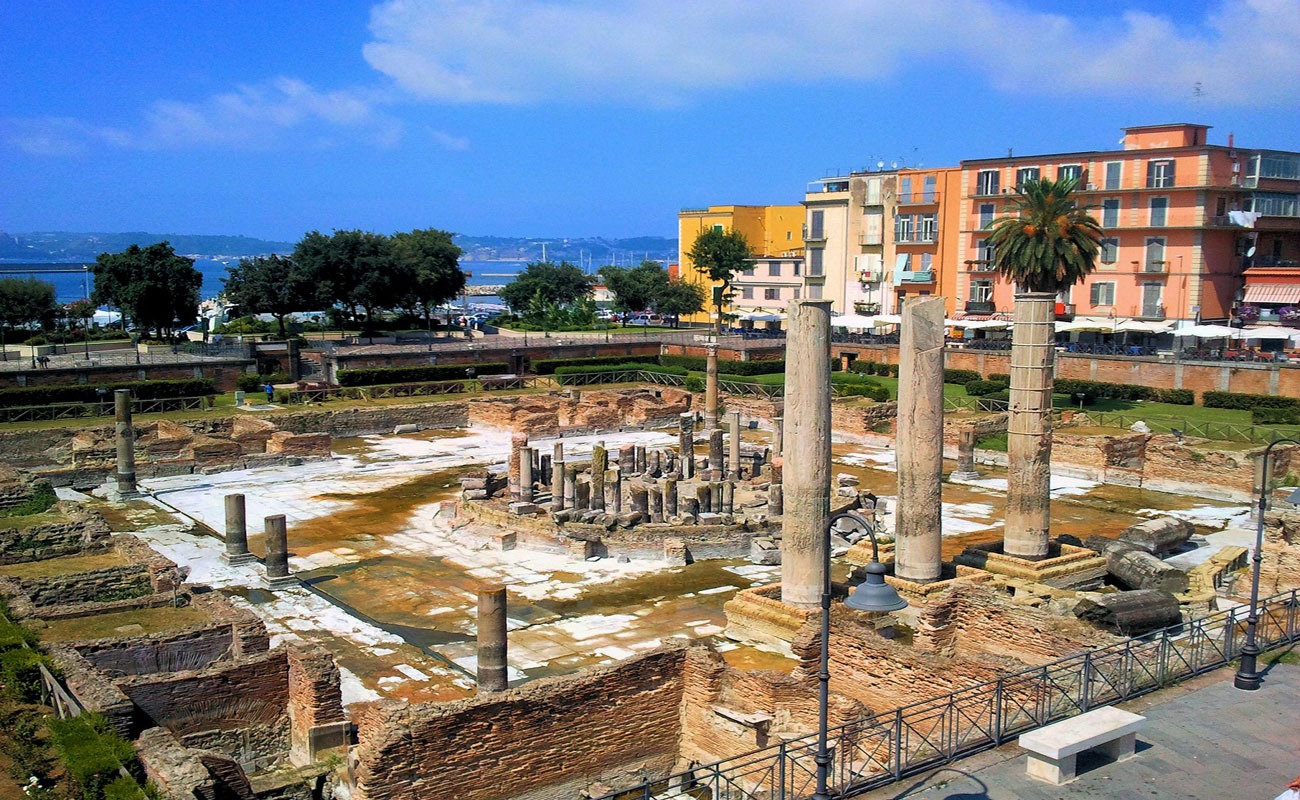
di

- Phlegrean Fields tours
Where the civilization of the western part of Italy began. Ischia (Pithecusa), is the place where it was founded the first Greek settlement in the ninth century BC and there is also an inactive volcano located in the area. The name derives from the Greek Phlegrean Fields (phlegraios – burning) and it is clear the reference to the volcanic nature of the area, for thousands of years of geological disasters, eruptions and bradisism have upset its nature which has constantly and often terribly changed. Have emerged and disappeared beaches, have formed new mountains, the hills are landslides, and the cities submerged. The Phlegraean Fields is a place full of history where there are small towns founded more than 2000 years ago that still exist and handed down ancient traditions. Cumae the first city founded on the mainland, by the Greeks in the eighth century. Very powerful city extended its dominion over the whole territory of Phlegrean and Neapolitan until Pozzuoli (Puteoli) assumed a major role in the Roman Empire. You can visit the ruins of the ancient city where you can admire the Temple of Zeus (Greek temple of the fourth century BC.), Temple of Apollo and in evidence there is the Sybil’s Cave, the legendary Sibyl was the priestess of Apollo. Baia located on the coast of the Gulf of Pozzuoli, was one of the most popular vacation spots for the Romans, the Roman city of Baia submerged due to bradyseismical event and now is protected in a marine park and it is possible to visit it by boat with glass bottom. The archaeological park of Baia is a small town formed by several buildings of different nature such as thermal baths, villas and four temples. In Baia there is the Aragonese Castle which also is home of the Archaeological Museum of the Phlegraean Fields and collect all the artifacts found during excavations in the Phlegraean Fields. The Locality of Misenum near the town of Bacoli, with its promontory, closes the Gulf of Pozzuoli in the position opposite to Capo Posillipo, was the naval base of the Roman fleet in the Tyrrhenian sea during the Augustan age also from the Roman period there is another remarkable testimony. The incredible Mirabilis Pool, enormous reservoir carved into the stone where fresh water was collected to supply the Roman ships. Pozzuoli is the main town of Phlegrean Fields, is the Roman city founded in the second century BC and built corresponding at the previous Greek settlement which in ancient time was the most important and powerful of Neapolis. It was a thriving commercial maritime city, fell into decline with the opening of the port of Ostia which took away part of trade, then with the fall of Rome and the bradyseisms became a fishing port. You can admire the ancient evidence as the Flavian Amphitheatre (the third in Italy), built in the late second century. B.C. could accommodate about 20000 people, the Temple of Serapis, so called thank to a statuette of the Egyptian god Serapis found in 700, but is the old Macellum included in the area port . Pozzuoli is characterized by the presence of the Solfatara which is a volcanic crater dating back to 4000 years ago and is characterized by the fumaroles and emissions of sulfur vapors.Natural event absolutely awesome is the formation of a hill in one night, it is called Monte Nuovo and is the youngest mountain in Europe, which was formed during the eruption of 29-30 September 1538. One of the ancient crater is now the nature reserve Astroni, some of them have become lakes such as Lake Averno mentioned by Homer and Virgil because it was considered the entrance to Hades kingdom of the underworld, the lake Fusaro where at its center there is a beautiful Casino Royal of Bourbon designed by Charles Vanvitelli and therefore known as Casina Vanvitelliana, and still others lakes. The hill of Posillipo is the headland that closes to the south sideof the Phlegraean Fields, is also the viewpoint from where you can admire the beautiful view of all the places mentioned, show unique beauty that has inspired great poets such as Virgil and Homer. Visit this area is a gift that everyone should do to themselves.
Filter by categories
Baia boat tour cymba.

Campania is a very special land, because here Nature with a one hand takes away and with the other gives. In fact the eruption of Vesuvius of 79 d.C. was a tragedy, but withou..
- view details
Phlegrean Fields Tour

Where began the civilization of the western part of Italy, Phlegraean Fields. It is not only one site but it is formed by different areas, the place of the beginning was Cuma ..
Information Request Form

The Phlegrean Fields
Travel guide.
- Things to Do
- Best Hotels
- Best Restaurants
- Planning a Trip
Things to See in The Phlegrean Fields
Exploring Pozzuoli
The modern town tightly encloses Pozzuoli's ancient monuments. The original Greek Acropolis, Rione Terra , was the first inhabited area of Pozzuoli. Located near the harbor, it has been progressively subsiding under the sea, so much so that it had to be abandoned in the 1970s. A large, ongoing excavation and restoration campaign, begun in 1993, has uncovered a virtually untouched Roman town -- a kind of underground Pompeii. Along the main Decumano (the central avenue running east-west) and some minor streets, are shops, osterie (taverns), a pistrinum (mill), and the ergastula (slaves' cells) with some drawings by prisoners still visible on the walls. At presstime, the site was closed to the public with no foreseeable opening date; call the tourist office for updates. Sculptures and other important objects from ancient Pozzuoli are on display in the Museo Archeologico dei Campi Flegrei in Baia.
Not far from the harbor, at Via Roma 10, is the entrance to the Serapeo , the ruins of the ancient town's marketplace. The large structure, built in the 1st century A.D., was lined with porticos where shops and taverns operated. At its center are the remains of a temple, much ruined over the centuries (its alabaster columns, for instance, were used to decorate the Royal Palace in Caserta). Named after the Egyptian god Serapis because of the statue found here during excavations, this ruin has been used to study the geological phenomenon of bradyseism where large tracts of land slowly subside beneath sea level while others rise up; you can see little holes in the marble of the columns where they were submerged in water. A bit farther inland, at Via Terracciano 75, is the Anfiteatro Neroniano/Flavio . Started by Roman emperor Nero and finished by Emperor Vespasiano, it is in the upper part of town, where the roads to Cuma, Pozzuoli, and Naples converged in Roman times. This was the third-largest amphitheater in the Roman world after the Colosseo and the Anfiteatro Campano in Capua. Admission for both sites is 4€; the ticket also includes the Museo Archeologico dei Campi Flegrei, Parco Archeologica di Baia, and Scavi di Cuma, and is valid 2 days. (June-Sept Wed-Mon 9am-7pm; Oct-May WedMon 9am-4pm, last admission 3pm; closed Jan 1, May 1, Dec 25). The theater, which could accommodate more than 20,000 spectators, is used today for special musical events; check with the local tourist office for information.
Exploring Solfatara
The site is a nature reserve covering an expanse of 33 hectares (81 acres), with large wooded areas where a number of rare birds, plants, and small animals have found refuge. At the entrance, Via Solfatara 161 (tel. 081-5262341; www.solfatara.it), pick up the nature trail that leads to the points of interest in the park; the whole thing takes about 45 minutes to 1 hour. Highlights are the Fangaia, with its huge bubbling mud holes, and the Bocca Grande, Solfatara's main crater. Because Solfatara is the epicenter of the Phlegrean Fields' volcanic area, the ancients believed this was the residence of the god Vulcanus. Nearby are the Stufe (Italian for stoves): a number of small caves constantly filled by hot steam. During antiquity, they were used as natural saunas. Entry fees are 6€ for adults, 4.50€ for children 4 to 9, and free for children 3 and under; Artecard holders receive a 20% discount. The park is open daily from 8:30am to 1 hour before sunset.
Exploring Baia
The unique attraction here is obviously the Parco Sommerso di Baia , Harbor of Baia (tel. 081-8688923; www.baiasommersa.it), the submerged archaeological site. The ruins are only a few feet below the surface, and the visit is an eerie and magical experience, however you choose to go about viewing it. Many of the structures have been excavated and in places roped off and labeled for visitors coming by guided scuba or snorkeling tour (not available in winter) or by boat equipped with a submerged video camera or clear bottom. Visits by boat are possible only during good weather (mid-Mar to mid-Nov Tues-Sun 9:30am-1:30pm and 3:30-7:30pm); boats depart from the dock in Baia's harbor, and the tours cost 25€ inclusive of admission, insurance, and boat transport. If you want to enjoy the ruins from underwater, a guided scuba tours costs 35€ and a snorkeling tours costs 20€ including boat transport, equipment hire, admission, and insurance. You can book these tours either through the park (at the above number) or with one of the local authorized diving centers: Centro Sub Campi Flegrei (tel. 081-8531563; www.centrosubcampiflegrei.it) or Centro Subacqueo 'Ulisse' (tel. 081-3043824 or 338-2918942).
The unsubmerged part of Baia boasts some quite exceptional ruins. The Parco Monumentale , Via Bellavista (tel. 081-8687592; free admission; open daily 9am to 1 hr. before sunset; last entrance 1 hr. before closing time) is a huge archaeological area covering 14 hectares (34 acres) of "historical landscape" on which excavations are ongoing and where you can walk among the ruins of imperial residences and elegant villas now shaded by pine trees to a backdrop of fabulous views. The Parco Archeologico Terme di Baia , whose main entrance is at Via Sella di Baia 22 (tel. 081-8687592; admission 4€, includes Anfiteatro Flavio and Serapeo in Pozzuoli, Museo Archeologico in Baia, and Scavi di Cuma, and is valid 2 days; Tues-Sun 9am to 1 hr. before sunset, last entrance 1 hr. before closing time; closed Jan 1, May 1, and Dec 25), features the ruins of the Imperial Palace and the thermal baths. These were the most celebrated of ancient Roman baths, beloved by the VIPs of ancient Rome both for the therapeutic properties of their waters and for the matchless scenery. Built by Emperor Ottaviano between 27 B.C. and A.D. 14, the baths took advantage of local, natural hot springs and were hydraulically engineered to be fed by gravity only. The shifting ground, however, altered the original construction, and little water reaches the baths today. We recommend starting with the Parco Monumentale and taking the scenic footpath , which starts from the Esedra (the park's main square) and connects with a secondary entrance to the Parco Archeologico (which doesn't offer ticket sales).
Don't miss the Museo Archeologico dei Campi Flegrei , Via Castello 39 (tel. 081-5233797 or 848-800288), a small but perfectly formed museum housed in the scenic Castello Aragonese which overlooks the harbor from atop a small promontory. Built in 1442 by Alfonso d'Aragona, the castle is worth a visit in itself, if nothing else for the view. Inside is a superb collection, including chunks of rooms that were carefully excavated from local ancient Roman villas and reconstructed here, such as the Sacello degli Augustali and the famous Ninfeo di Punta Epitaffio (a ninfeo is an ancient Roman porch enclosed with columns -- this one was found underwater) from the excavations of Baia and Miseno, and the Ninfeo of Emperor Claudius. Admission is 2.50€, or you can buy a combined ticket for 4€ that includes the entrance to Anfiteatro Flavio and Serapeo in Pozzuoli, Zona Archeologica in Baia, and Scavi di Cuma (valid 2 days). Hours are Tuesday to Sunday from 9am to 1 hour before sunset (museum closed Jan 1, May 1, and Dec 25).
Baia is also a good base for exploring the bay; you can rent a boat from the Associazione Barcaioli di Baia (tel. 081-8701222 ), or join an organized boat excursion with the ferry company Alilauro (tel. 081-4972222; www.alilauro.it). All the above companies are located along the dock in the harbor.
Last but not least, you can enjoy a bit of relaxation ancient-Roman style in the spa Terme Stufe di Nerone, Via Stufe di Nerone 45, Bacoli (tel. 081-8688006; www.termestufedinerone.it), where there are two operating natural saunas. Hours vary, so call before your visit.
Exploring Cuma
The entrance to the archaeological area, Parco Archeologico di Cuma (tel. 081-8543060 ), is at Via Acropoli 1. The site has several ruins. On the Acropolis are two temples -- one to Apollo and the other to Jupiter -- which served as churches from the Middle Ages; beyond the fortified walls is the Necropolis and an amphitheater dating from the late 2nd century B.C. Nearby is Cuma's most intriguing and atmospheric site, the mysterious Antro della Sibilla (Sibylla's cave) . According to legend, this is where the famous oracle received her supplicants. Whatever the truth, the majestic proportions of the long, narrow trapezoidal tunnel and the engineering feat of its construction out of sheer rock are admirable. The terrace outside the cave provides a splendid view over the harbor of Cuma, which is in itself reason enough for a visit. Admission to the park alone is 2.50€ or you can buy a combined ticket for 4€ that includes entry to the Anfiteatro Flavio and the Serapeo in Pozzuoli, the Museo Archeologico and the Zona Archeologica in Baia, and is valid 2 days (daily 9am to 1 hr. before sunset; last admission 1 hr. before closing time; closed Jan 1, May 1, and Dec 25).
As you leave the excavations, notice the imposing arch the local road passes under: Named Arco Felice by locals, it dates from the 1st century A.D., when the mountain was cut and a viaduct was built for the passage of the Domitian Road, an immense engineering feat realized under Emperor Domitian. Also nearby is Lake Averno: Described by classic poet Virgil in the Aeneid as the entrance to the underworld, this volcanic lake is strangely dark and quiet. Its name is ancient Greek for "no birds," and it is believed that volcanic vapors might have kept the animals away. Despite its dark fame, in 37 B.C. Marco Agrippa had it connected via a long channel to the nearby lagoon Lucrino for use as a Roman shipyard. On the eastern shore are the remains of a large thermal bath complex, known as Tempio di Apollo.
The largest of the volcanic lakes is Lake Fusaro , a short distance farther to the south. It was known to the ancients as Acherusia Palus, or the Infernal Swamp. In 1782, quite indifferent to the ancients beliefs, Ferdinando IV Bourbon had architect Carlo Vanvitelli (son of the famous Luigi) build a hunting and fishing lodge, the Casina Reale (Via Fusaro, Bacoli), on a little island in the lake. You can arrange a visit by appointment only (tel. 081-8687080 ).
Note : This information was accurate when it was published, but can change without notice. Please be sure to confirm all rates and details directly with the companies in question before planning your trip.

- All Regions
- Australia & South Pacific
- Caribbean & Atlantic
- Central & South America
- Middle East & Africa
- North America
- Washington, D.C.
- San Francisco
- New York City
- Los Angeles
- Arts & Culture
- Beach & Water Sports
- Local Experiences
- Food & Drink
- Outdoor & Adventure
- National Parks
- Winter Sports
- Travelers with Disabilities
- Family & Kids
- All Slideshows
- Hotel Deals
- Car Rentals
- Flight Alerts
- Credit Cards & Loyalty Points
- Cruise News
- Entry Requirements & Customs
- Car, Bus, Rail News
- Money & Fees
- Health, Insurance, Security
- Packing & Luggage
- -Arthur Frommer Online
- -Passportable
- Road Trip Guides
- Alaska Made Easy
- Great Vacation Ideas in the U.S.A.
- Best of the Caribbean
- Best of Mexico
- Cruise Inspiration
- Best Places to Go 2024
The Phlegrean Fields Tour: a volcanic visit!
The Phlegrean Fields are a volcanic area located west of the city of Naples, among the Gulf of Pozzuoli, Mount of Procida and the Fusaro area. They extend to the hills of Posillipo, Camaldoli and Quarto to the Acropolis of Cuma. The area is of great geological interest given the vigorously volcanic nature of the Phlegrean area. It also has a great historical significance, being in a strategic position to several routes.
In the area, there are numerous craters and small volcanic buildings (at least twenty-four), some of which have effusive gases (Solfatara) or hydrothermal activity (Agnano, Pozzuoli, Lucrino).
The route from Naples to the Phlegrean Fields is not very long and is very enjoyable. Among the many human works to be visited in the area, the tour may start from the visit of the Solfatara, a crater still active but in a quiescence state, about 3 km from the city of Pozzuoli. The visit will take you to the inside of the crater and walk among the fumaroles . A Solfatara is, therefore, a volcanic zone with many fumaroles emitting gases with a high sulphur content. And it takes its name from the Solfatara of the Pozzuoli area, in the Phlegraean Fields .
Before arriving at the fumarole area, you have to pass through the Solfatara Naturalistic Oasis , made of Mediterranean scrub and oak forests. It will be a volcanic adventure!
After experiencing the Solfatara and its distinctive sulphur smell, it is worth visiting the Flavian Amphitheater, a Roman amphitheatre built in the 1st century AD and the third largest after the Colosseum and the Amphitheater Campano .
In the underground, about 7 meters deep, some parts of the gears that lift the cages carrying the wild beasts in the arena, are still visible.
Archaeological excavations began in 1839 but, only in 1947, after new excavations, the monument was definitively released from all the debris.
During your tour of the Phlegrean Fields, don’t forget to stop at the ancient city of Cumae to visit the Acropolis and the Cave of the Sybil, mentioned by the poet Homero . The archaeological site of Cuma lies between Bacoli and Pozzuoli. It was the oldest colony and the farthest from the motherland. The name Cumae comes from Greek and means “wave”. Its location was strategic considering the city on a hill near the sea.
Underwater Archaeological Park and Archaeological Museum of the Phlegrean Fields
Before returning to the hotel, do not miss a visit to Baia , a beautiful seaside village, in an area that at the time of the Romans was a key strategic port. Baia is also famous for an Underwater Archaeological Park in perfect condition, and for the Archaeological Museum of the Phlegrean Fields , located in the Aragonese Castle overlooking the entire bay.
The Phlegrean Fields are a territory of strong energy that deserves to be seen. Book now the tour of the Phlegrean Fields!


- Volcano news
- Volcanoes Today
- Which volcanoes are erupting now?
- Volcano Glossary
- Latest VAAC advisories
- Earthquakes
- Latest Quakes
- By Country/Region
- Find quakes
- Report a Quake!
- Global Seismic Activity Level
- Volcanoes & Earthquakes App
- Destinations
- Support us to maintain this site!
Guaranteed tours
Campi flegrei (phlegrean fields) volcano.
The Campi Flegrei ("burning fields") or Phlegrean Fields is a large, 13-km-wide nested caldera located under the western outskirts of the citiy of Naples and under the Gulf of Pozzuoli. It contains many volcanic centers (cinder cones, tuff rings, calderas) that have been active during the past 30-40,000 years. The volcanic field has been the site of some extremely violent eruptions in the past, although the few ones that occurred during historic times were small events. Today, there is no sign of imminent reawakening of activity, although there are abundant signs of the presence of a still active magma chamber in the forms of solfataras, warm springs, gas emissions etc. In particular, the Campi Flegrei is infamous for its frequent episodes of major ground deformation in the form of large-scale up- and downlift of the ground (bradisism, see below).
Latest nearby earthquakes
Latest satellite images.
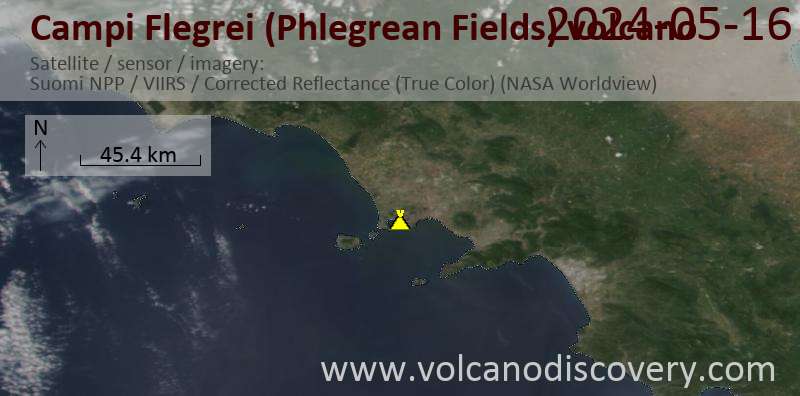
Campi Flegrei volcano (Italy): periods of seismic swarms go on
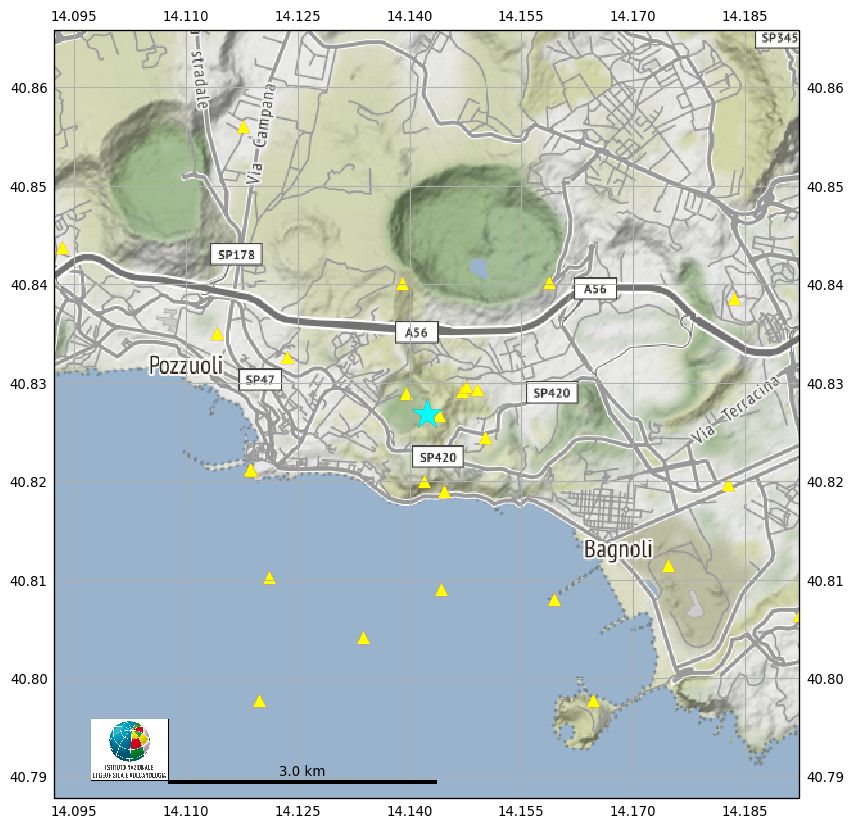
Campi Flegrei volcano (Italy): yet another seismic swarm is ongoing
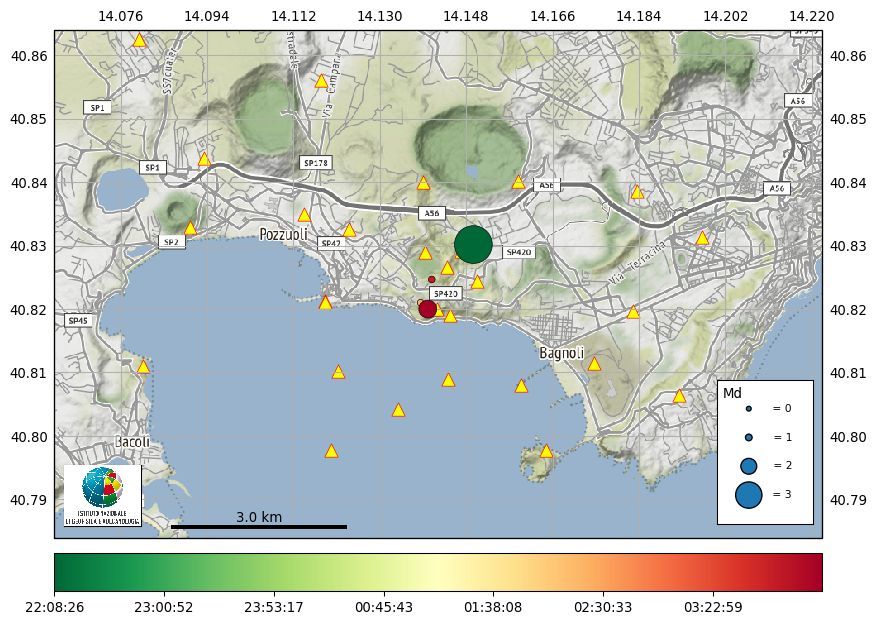
On this page:
More on volcanodiscovery.
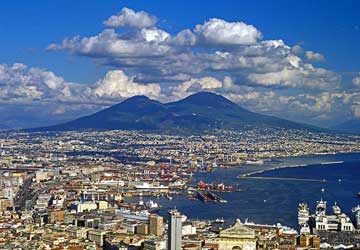
Blog categories
- No categories
The Phlegrean Fields

[email protected] +39 081 090 0180

Manifesto dell’Ospitalità Nuova Xenìa Flegrea
The Phlegraean fields
Accomodation
Food&Wine
Privacy Overview

- Volcano news
- Volcanoes Today
- Which volcanoes are erupting now?
- Volcano Glossary
- Latest VAAC advisories
- Earthquakes
- Latest Quakes
- By Country/Region
- Find quakes
- Report a Quake!
- Global Seismic Activity Level
- Volcanoes & Earthquakes App
- Destinations
- Support us to maintain this site!
Guaranteed tours
Campi flegrei (phlegrean fields) volcano.
The Campi Flegrei ("burning fields") or Phlegrean Fields is a large, 13-km-wide nested caldera located under the western outskirts of the citiy of Naples and under the Gulf of Pozzuoli. It contains many volcanic centers (cinder cones, tuff rings, calderas) that have been active during the past 30-40,000 years. The volcanic field has been the site of some extremely violent eruptions in the past, although the few ones that occurred during historic times were small events. Today, there is no sign of imminent reawakening of activity, although there are abundant signs of the presence of a still active magma chamber in the forms of solfataras, warm springs, gas emissions etc. In particular, the Campi Flegrei is infamous for its frequent episodes of major ground deformation in the form of large-scale up- and downlift of the ground (bradisism, see below).
Latest nearby earthquakes
Latest satellite images.

Campi Flegrei volcano (Italy): periods of seismic swarms go on

Campi Flegrei volcano (Italy): yet another seismic swarm is ongoing

On this page:
More on volcanodiscovery.
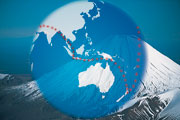
Support us - Help us upgrade our services!
- Improved multilanguage support
- Tsunami alerts
- Faster responsiveness
- Design upgrade
- Detailed quake stats
- Additional seismic data sources


Best Things To Do in Naples, Italy
“You either love it or you hate it,” said a friend of mine. It was the first thing I ever heard about the Italian city of Naples, and the phrase’s authenticity remains intact after all these years. Naples is unlike any other city in Italy: It is busy, loud, and dirty on one hand (many people say it feels like stepping into a Middle-Eastern bazaar) and creative, friendly, and picturesque on the other.
Naples is probably one of the most controversial cities in Italy. People either love it or hate it, it seems. Italy’s third-largest city is famous for its Neapolitan Pizza and a gateway to Pompeii, but not many people actually choose to stay in Naples . But there are actually a lot of really interesting things to do in Naples, Italy.
Top Things to do in Naples Italy
Neapolitan pizza.
Yes, in Naples, Pizza is a point on the itinerary. Neapolitan-style pizza has been heralded the world over for being the true pizza, however, those who’ve been to Naples know that no two pizzaioli (pizza chefs) make the same pizza. In short, there is no one authentic Neapolitan-style pizza , though many will argue otherwise . To discover which pizzaiolo’s pizza is your favorite, there’s no other way than by visiting Naples. Here are a few tips to help you on your way.
Some pizza chefs in Naples believe that there are only two kinds of pizza: Margarita and Marinara . A marinara pizza, put simply, is dough, garlic, and sauce; and a Margarita pizza is dough, sauce, and cheese. While this doesn’t do much for the Hawaii-style pizza lover, don’t let the simplicity fool you; these are the makings of the best pizzas on earth.
Book your Neapolitan Pizza Making Class here>>
Book your Naples Food Walking Tour here>>
Naples National Archeology Museum
Speaking of Pompeii, its most striking artworks were carried off to the National Archeology Museum . While this means that they are not on display in Pompeii (which is OK, in my opinion, because there is already plenty to see in Pompeii), it also ensures that they won’t be buried for another 1500 years the next time Mt. Vesuvius explodes.
Here’s my advice: Go to Pompeii first, then go to the National Archeology Museum. Is it worth it? Yes, yes, and yes. The artwork, statues, and artifacts are absolutely striking and give you yet another side to the fantastically preserved city. The museum also includes many of the statues from the Farnese Collection. The famous art collection is split up between the National Archeology Museum and Capodimonte Museum. To really appreciate the exhibits, you should definitely get the audio guide when you tour the museum.
Book your museum ticket here>>
Book your museum ticket with audio guide here>>
Directions | Piazza Museo, 19, 80135 Napoli NA, Italy
Phlegrean Fields
One of the most confusing sights ever, the Phlegrean Fields is a large volcanic area, not a single location. It encompasses everything west of Naples (to the coast) as well as several islands, including the famous Ischia and Procida.
To do the area justice, you should spend at least two days there. The tickets (4 euro) give you access for two days. This includes, most importantly, the famous Cave of Sybil in Cuma, the striking crater lakes, the Flavian Amphitheater, and the Baia Archeology Museum and Park.
The tickets exclude, most importantly, the Solfatara, a bubbling lava lake once believed to be the entrance to hell, and the underwater city of Baia. The Solfatara costs an extra 6 euro, and the underwater city can only be seen from a glass-bottomed boat, which is easily chartered in Baia for a fee.
When you consider the sheer size of the Phlegrean Fields and the large number of exceptional sights, it seems like it’s worth a visit. But because the area is so spread out, and none of its ruins are as well preserved as those found in Pompeii and Herculaneum, the jury is divided.
If you have a limited time in Naples and you’ve never seen Pompeii, visiting the Phlegrean Fields is not worth it. If you’ve already seen Pompeii and you’ve got two spare days, expand your circle of ancient experience and see where the richest of the rich Romans once lived. The area’s volcanic activity has resulted in a large number of natural thermal spas.
Directions | 80078 Pozzuoli, Metropolitan City of Naples, Italy
Castles of Naples
Castel sant’elmo.
This medieval castle sits on top of a hill near Certosa di San Martino, overlooking the city of Naples. It was built between 1200-1537 and is still in use today.
Castel dell’Ovo
This seaside castle was built on the island of Megaride, which is now a peninsula in the bay of Napoli. Built in the 5th century, it is the oldest castle in Naples.
Castel Nuovo
The Castel Nuovo – also known as Maschio Angioino – is located right in the heart of Naples. It was built in 1279 and used as the royal seat for kings of Naples, Aragon, and Spain until 1815.
Capodimonte Museum
The grounds of this museum alone are enough to make it worth a visit. Located in a beautiful park on a hilltop that overlooks Naples, the museum was built for one reason, and one reason only: to house the Farnese Collection . One of the most important art collections on earth, it includes works by many famous Italian painters and sculptors.
Its paintings are located inside the Capodimonte Museum, and its sculptures are in the National Archeology Museum. Many works are featured besides those of the Farnese Collection, including some excellent Caravaggios. A portion of the museum is dedicated to contemporary art, including some freaky Andy Warhols. The Capodimonte Museum is definitely worth it.
Directions | Via Miano, 2, 80131 Napoli NA, Italy
The Royal Palace in Caserta
A 40-minute train ride gets you to Caserta, and the trains leave Naples central station every 20-30 minutes. The Royal Palace is located across the street from the Caserta train station, making it easy to visit on foot. The palace was built by Charles of Bourbon, who was King of Naples in the mid-18th century. He wanted it to be more grand than Versailles.
I’m not sure whether his architect, Luigi Vanvitelli, failed, or whether the grounds are not well kept, but I found the palace bland. The hedges and the grass were not closely manicured, and very few flowers were in bloom. From the outside, the palace did not impress me in any way other than its sheer size. Inside, the rooms were beautifully decorated.
Besides having a picnic on the lawn—with a 40-meter manmade waterfall cascading in the distance—my favorite part of the visit was the gold leafing and ancient Venetian glasswork inside. Entrance costs 8 euro. The grounds are so large that a bus service runs around the grounds; a round-trip ticket (from the castle to the end of the grounds and back) costs 1 euro.
I suggest immediately catching the bus and taking it to the far end of the grounds; indulge in the English Garden, then walk back beside the waterway. Buses leaving from the palace and going out to the grounds are not crowded; coming back is another story. Is the Royal Palace in Caserta worth it? Not unless you’re traveling with children
Directions | Viale Douhet, 2/a, 81100 Caserta CE, Italy
Underground City of Naples Italy
Ok, so I’ve come around to accepting that there are other things to do in Naples than eat pizza. It was tough though and took something as tremendous as Naples Underground, or Napoli Sotterranea, to prove it to me. It’s as creepy as any underworld tale, but there’s a friendly guide to take you through the twisting, winding passages below the streets of Naples.
Underground of Naples Tickets
There are a number of Naples underground tours , each beginning in different parts of the city, with each tour revealing different sections of Naples Underground. The tour my girlfriend and I took featured the underground remains of a Greek-Roman theater. It began in the vicinity of the Duomo di Napoli.
The small gift shop at the ticket office has a window in the floor that offers a glimpse into the world below. English language tours leave throughout the day, and when we arrived without reservations, we only had to wait 15 minutes for the next tour. I can now attest that the experience is well worth your time and money.
Naples Underground Tour
We followed our guide down a deep, long stairway until reaching a series of large rooms with towering ceilings. Our guide explained the ancient method of constructing homes in the area over 2400 years ago, which created the underground city that we were now walking through. The inhabitants dug large holes to excavate stone that they then used to construct houses. The large holes were subsequently used as wells.
After enough people had populated the area, there were so many wells that they were connected to create massive underground aqueducts. At one point, the aqueduct was so large that it connected Naples to Rome, a distance of nearly 140 miles.
The aqueducts were eventually closed down when cholera swept through Europe and they were never again used to provide drinking water. During WWII, some of the people in Naples decided to use the underground city as a bomb shelter; creepy toys and graffiti from that time period can still be seen.
A few of the rooms are still used today, some for biology experiments, and some to serve as a venue for art shows. There were also rooms with water in them, making for a stunning visual experience.
Explore by candlelight
My favorite part of the tour was the candle-lit trip through some very narrow passages. This part of the tour, however, may not appeal to people of large bearing or those with claustrophobia. Everyone in the group is given a candle and taken on a short journey through thin passages and into a room that features some pretty incredible sights.
I’m going to leave those sights a secret, however. I can’t give it all away! The tour guides are very good at creating fun surprises and I wouldn’t want to ruin the anticipation and excitement for readers who will one day take the tour.
Though the underground city has been mapped for over fifty years, the endeavor still struggles to raise enough money to unearth more of its incredible remains. When our guide showed me a map that depicted the size of the underground city, I was amazed to find that it stretched well beyond the current borders of Naples. Our tour, we were told, includes less than 1% of the giant, Naples Underground.
Book your Naples Underground Tour here >>
Is Naples Worth a Visit?
Naples is unlike any other city in Italy: It is busy, loud, and dirty on one hand (many people say it feels like stepping into a Middle-Eastern bazaar) and creative, friendly, and picturesque on the other.
It is definitely not a quiet, romantic Italian town like Siena or Verona. Threats of pickpockets and a pervasive garbage problem keep many travelers from even visiting the city, while a one-of-a-kind culinary scene, inexpensive shopping, and a vibrant waterfront make it a must-see for others. If you haven’t guessed already, I fall in the latter group.
The first time I visited Naples, I was immediately taken aback by its sheer bustle. I still attest to seeing a family of six—with a pet—whiz past me on a moped. The streets are small and the traffic is frantic. And the large outdoor market in front of the central train station is overwhelming and seemingly chaotic. However, once I became accustomed to the energy of Naples, I discovered the unique qualities that fueled it.
The people in Naples are friendly and welcoming, and always willing to help. For example, the clerk at the hotel where I usually stay is always giving guests tips on the best things to see and do. He also warns of pickpockets and provides extensive advice on how to carry money and cameras. In the stores and restaurants, people are quick to ask you where you are from and to welcome you to their city.
Naples Castles, Markets, and Architecture
The things to do in Naples are its two castles, the Naples National Archaeological Museum—considered the most important archeological museum in Italy—, tours of its underground city Sotterranea, and a waterfront full of beautiful sailboats and traditional fishing boats. The bay of Naples, on which the city sits, provides a clear view of the ancient Vesuvius volcano that buried the nearby city of Pompeii in 79AD. The Castle dell’Ovo is located on a tiny island that is joined to Naples by a short bridge and is free to visit. Castle Nuovo , which costs 5 euro to enter, is the more striking castle, with ancient stonework and dramatic towers.
Finally, the architecture of Naples won’t be forgotten, as huge churches, cathedrals, and other strutures of Medieval, Renaissance, and Baroque periods are found throughout the city. My favorite spots are the Piazza Dante , which boasts a great statue of Dante, and the Piazza del Plebiscito (especially at night). With Naples, I’ve found that looking beyond the crumbling apartment buildings provides an exciting glimpse into a city that is truly unlike any other on earth.
The markets in Naples are a great place to find clothes, shoes, purses, sunglasses, hats, and so on. However, they are known for pickpockets, so keep your money hidden or spread out between different pockets. If you try on shoes, the venders will provide you a seat. And, bartering is a way of life in the markets, so never pay the listed price.
Foods to try in Naples
From a culinary perspective, Naples offers traditional Italian foods that cannot be found anywhere else—not even in other Italian cities. Neapolitan pizza is, of course, at the forefront and you have your pick of top pizzerias in Naples .
The street food, which is sold from open storefronts around every corner, is some of the best in Italy. Fried panini stuffed with meats and cheeses, arancini (deep-fried risotto balls stuffed with mozzarella), calzones, and an assortment of fried vegetables and potatoes (sold for 30 cents a piece), should not be missed.
Further, the pastries in Naples are incredible. Sfogliatelle is a horn-shaped pastry that looks like it is made with circles of layered flakey crusts. Traditional biscotti are also served, though bear no resemblance to the dried, crunchy biscotti found in the United States. And espresso in Naples is definitively some of the best in Italy.
As you can see, Naples is worth a visit and there are plenty of attractions to keep you busy for a few days and fill the time between Pizzas.
Things to do in Naples Italy – Pin for Later:
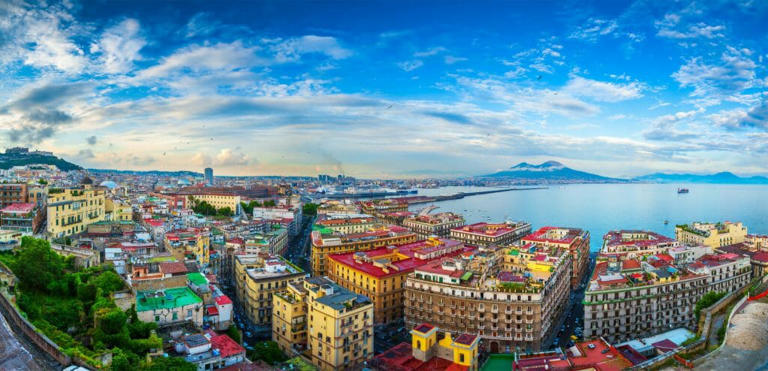
Things to Do in Nizhny Novgorod, Russia - Nizhny Novgorod Attractions
Things to do in nizhny novgorod.
- 5.0 of 5 bubbles
- 4.0 of 5 bubbles & up
- 3.0 of 5 bubbles & up
- 2.0 of 5 bubbles & up
- District Central (TsAO)
- Boulevard Ring
- 3rd Transport Ring (TTK)
- Garden Ring
- Red Square & Kitay-gorod
- Good for a Rainy Day
- Good for Kids
- Budget-friendly
- Good for Big Groups
- Good for Couples
- Honeymoon spot
- Good for Adrenaline Seekers
- Hidden Gems
- Adventurous
- Things to do ranked using Tripadvisor data including reviews, ratings, photos, and popularity.

1. Galileo Wonderland Park
2. Church of Nativity of Most Holy Mother of God

3. Pechersky Ascension Monastery

4. Fedorovsky Embankment

5. Cathedral of St. Alexander Nevskiy
6. Limpopo Zoo
7. State Bank

8. Rozhdestvenskaya Street

9. Verhnevolzhskaya Embankment
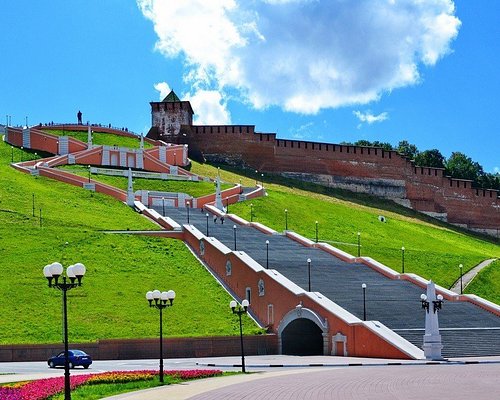

10. Chkalov Staircase
11. Chkalov Monument
12. Bolshaia Pokrovskaia Street

13. Muzey Starinnoy Tekhniki I Instrumentov
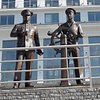
14. The Kremlin

15. Usad'ba Rukavishnikovykh

16. Nizhny Novgorod Cableroads

17. Sculpture the Funny Goat
18. Monument to Minin and Pozharsky
19. High Speed Train Strizh
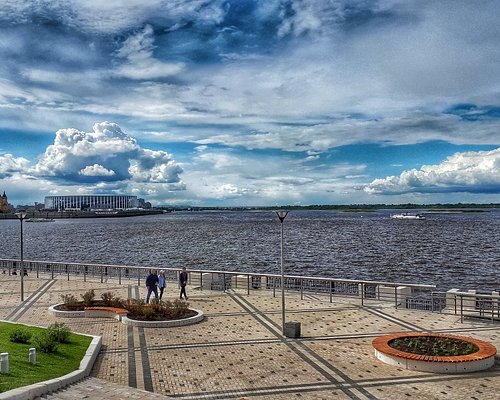
20. Nizhne-Volzhskaya Embankment

21. Nizhny Novgorod State Art Museum

22. Russian Museum of Photography

23. Dmitriyevskaya Tower

24. Nizhny Novgorod Stadium

25. Pozharsky and Minin Square

26. Claustrophobia

27. Monument to Yevgeniy Yevstigneyev

28. Gorkovskiy Museume of Locomotives

29. Yurkovka Art Gallery

30. Neskuchny Nizhniy
What travelers are saying.
- Limpopo Zoo
- The Kremlin
- Fedorovsky Embankment
- Nizhny Novgorod Cableroads
- Chkalov Staircase
- Nizhny Novgorod Ekzotarium Exhibition Center
- Gnev Chelovecheskiy
- Park of the 800th Anniversary of Nizhny Novgorod
- Galileo Wonderland Park
- Church of Nativity of Most Holy Mother of God
- Pechersky Ascension Monastery
- Cathedral of St. Alexander Nevskiy
Districts [ edit ]
The city is divided by the River Oka into two major parts: the Upper city ( Verkhnyaya or Nagornaya chast ) on the hilly right side and the Lower city ( Nizhnyaya or Zarechnaya chast — what literally means "the part over the river") on the left bank of the river. The Upper city is the old historical part of Nizhny Novgorod, whereas the Lower city is larger, newer and consists of more industrial districts.
Understand [ edit ]

History [ edit ]
The city was founded by Grand Duke George II of Russia in 1221 at the confluence of two most important rivers of his principality, the Volga and the Oka. Its name literally means Newtown the Lower , to distinguish it from the older Novgorod . A major stronghold for border protection, Nizhny Novgorod fortress took advantage of a natural moat formed by the two rivers.
Along with Moscow and Tver, Nizhny Novgorod was among several newly founded towns that escaped Mongol devastation on account of its insignificance and grew up into important centers of Russian political life during the period of Tatar yoke. For a short period of time it was the capital of the Suzdal Principality and competed with Moscow for the power in the region. However the competition with Moscow was lost and in 1392 the city was incorporated into Muscovy. Nizhny Novgorod Kremlin was built in 1508-1511 (under supervision of the Italian fortress engineers) and became one of the strongest Russian citadels. There is a legend saying that the project was initially developed with participation of Leonardo da Vinci. However there is no documented proof of Leonardo's work for that project, the only thing the legend is based on is the striking resemblance of Leonardo's sketches and the actual Kremlin schemes. The fortress was strong enough to withstand Tatar sieges in 1520 and 1536.
In 1612, the so-called national militia , gathered by a local merchant Kuzma Minin and commanded by Knyaz Dmitry Pozharsky expelled the Polish troops from Moscow, thus putting an end to the Time of Troubles and establishing the rule of the Romanov dynasty.
In 1817, the Makaryev Monastery Fair, one of the liveliest in the world the 16th-18th centuries, was transferred to Nizhny Novgorod, which thereupon started to attract numerous visitors and by the mid-19th century it turned Nizhny Novgorod into trade capital of the Russian Empire.
Under the Soviet period, the trade connections of the city were abandoned and Nizhny Novgorod became an important industrial centre instead. During the communist time the city was closed to foreigners to safeguard the security of Soviet military research. The physicist and the Nobel laureate Andrei Sakharov was exiled there during 1980-1986 to limit his contacts with foreigners.
Climate [ edit ]
The climate in the region is humid continental and it is similar to the climate in Moscow , although colder in winter, which lasts from late November until late March with a permanent snow cover.
By car [ edit ]
Nizhny Novgorod is situated on the M7/E30 road. The road is in decent condition, although with traffic it can take anywhere from 4 to 8 hours to drive to/from Moscow .
By boat [ edit ]
Turflot [dead link] , Infoflot , and many other companies operate multi-day river cruises down the Volga from early May to the end of September.
Many companies operate passenger boat service between Moscow and Astrakhan , with stops at most cities along the Volga River.
Get around [ edit ]
By foot [ edit ].
The city centre is compact and walkable. However, there are many inclines or steps from the river banks. The bridges are not pedestrian friendly since the sidewalk is very narrow and cars drive extremely fast close to the pedestrians.
By city rail [ edit ]
The City Rail connects areas where there are no metro lines. Connects with the subway at the Moscow railway station. It has 2 lines: Sormovskaya and Priokskaya. The fare by train costs 28 rubles. According to the Citicard Transport Card, the fare is 26 rubles. Also by train you can get to the nearest suburb, or transfer to suburban trains to Dzerzhinsk, Bor, Semenov or Arzamas.
By bus and trolleybus [ edit ]

As of May 2017 in each district of the city there are several city bus routes. The number of trolleybus routes is much less. In one district of the city there are 1-2 trolleybus routes. Trolleybus routes are completely absent in the Leninsky city district. It is worth noting that trolleybuses do not connect the Lower City to the Upper. This is because the trolleybuses do not have enough power to climb the mountain.
The trolleybus network is divided into 3 parts:
- The upper trolleybus network (it unites all three districts - Nizhegorodsky, Sovetsky and Prioksky) with a turning circle on the Minin Square, near the Kremlin.
- The lower trolleybus network (connects Kanavinsky, Moskovsky and Sormovsky districts)
- The Avtozavod trolleybus network (connects all the distant sleeping microdistricts among themselves)
By tram [ edit ]
Throughout the city, land trams run. The longest route of all is 417. It connects the outskirts of Avtozavodsky district with the Moskovsky Rail Terminal. The journey takes about 1 hour and 20 minutes. The route passes through the sleeping areas (approximately 75% of the way). Also in remote neighborhoods there are routes of several more trams, but in most cases, they are in the Upper City. By the way, you can reach there by tram 27 or 10 directly from the Moscow railway station.
By marshrutka [ edit ]
Marshrutkas do not stop at every stop. To indicate your intention to exit a marshrutka, press a button and to indicate your intention to enter a marshrutka en-route, you need to wave your hand.
By bicycle [ edit ]
Nizhny Novgorod has not very developed bicycle infrastructure. Special bike paths exist only on the Upper-Volga and Lower-Volga embankments and on Rozhdestvenskaya Street.
The upper city is very hilly and full of steep inclines and even many locals will get off their bicycles and push their bikes up the hill by foot. Drivers can be reckless and pose a danger to cyclists. The roads can also be icy during the winter. City cyclists solve this problem by replacing summer tires with winter tires.
Also, in 2017 the implementation of a new integrated transport scheme of the city began. It provides for a large number of bicycle paths in the Upper City (including on Bolshaya Pokrovskaya Street) and in the Lower City.
See [ edit ]
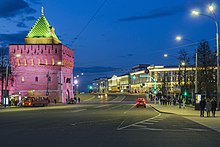
Monuments [ edit ]
- Monument to Valery Chkalov, the famous test pilot of the 1930s, known for his ultra long flight from Moscow to Washington State via the North Pole.
- Maxim Gorky, at the square named after him
- Alexander Pushkin (at the entrance to the Theatre of Opera and Ballet)
- 56.327974 44.001982 26 Prince George and Saint Simon of Suzdal , The Kremlin, St. Michael the Archangel Cathedral . Monument to the founders of the city of Prince Yuri II of Vladimir (also George Vsevolodovich) and Simeon of Suzdal ( updated Jun 2017 )
Religious [ edit ]
- Pechersky Ascencion Monastery , near Sennaya Square a couple miles east of downtown, halfway down the slope to Volga. With a cathedral and several churches surrounded by a restored stone wall, the monastery is the seat of the archbishops of Nizhny Novgorod.
- A big variety of other churches and convents.
Buy [ edit ]

Sleep [ edit ]
All hotels and hostels offer free Wi-Fi and many have computer terminals. Almost all accept credit cards. Hotels and hostels will usually provide a visa invitation and registration for an additional fee.
Connect [ edit ]
Phone [ edit ].
For information on purchasing a SIM card in Russia, see Russia#Connect .
Note that Nizhny Novgorod is in the Volga region zone, and SIM cards purchased elsewhere, such as in Moscow or Saint Petersburg , may be subject to roaming charges.
There are payphones in the streets; however, you can only buy phone-cards in the post offices and in a few newspaper kiosks.
Internet [ edit ]
Free WiFi is available in most hotels, shopping malls, university buildings, restaurants and cafes, the airport as well as several metro stations. There is also free public WiFi on B. Pokrovskaya street.
Cope [ edit ]

Navigation menu
The Top 12 Things to Do in Nizhny Novgorod, Russia
Take a first-rate trip to Russia's fifth city
Ershov_Maks/Getty Images
Although it's Russia's fifth-largest city, you could be forgiven for never having heard of Nizhny Novgorod. Notwithstanding that another Russian city is simply called " Novgorod ," the current name of the city just doesn't have a memorable ring to it. (By contrast, its name during the Soviet years — Gorky, like the famous author — was much more iconic.) At any rate, this city of just over a million around six hours east of Moscow is more than worth a visit. These are just 12 reasons why!
Tour the Kremlin's 13 Towers
Like most every other city in Russia, Nizhny Novgorod is home to a Kremlin. (The word "kremlin" means "citadel" in Russian, and has nothing to do with the modern Russian government) One thing that elevated the Kremlin of Nizhny Novgorod above others in Russia (with the possible exception of the Moscow Kremlin and one or two others), however, is the fact that its wall has 13 towers. During the summer months, at least one free walking tour per day operates from the main entrance of Nizhny Novgorod's Kremlin.
Climb Russia's Longest Staircase
Named for one of the most famous Russian pilots of the early aviation age (Valery Chkalov), the Chkalov Stairs connect two of Nizhny Novgorod's public squares, which sit on the upper and lower embankments of the Volga River, respectively. Built in 1943 (during the period when Nizhny Novgorod was known as Gorky), the Chkalov Stairs currently have the distinction of being the longest staircase in Russia.
Go Wild at Limpopo Zoo
One thing that surprises many travelers to Nizhny Novgorod is how amazing its zoo, colloquially known as Limpopo is. In addition to being home to a tropical botanical garden (which, not surprisingly, is indoors), the zoo hosts a variety of reptiles, mammals and birds. There's also a small sculpture park on the grounds of Nizhny Novgorod's zoo, including both original and replica pieces.
Shop (or Just Stroll) Along a Storied High Street
Bolshaya Pokrovskaya Street has been the de-facto "Main Street" of Nizhny Novgorod for more than 200 years. Well, minus the Soviet Union period, during which the cafes that once (and now) lined it became somewhat worthless, since intellectual conversations were basically forbidden. These days, you can come here for a cup of Russian tea then shop at the dozens of boutiques you'll find on either side of the street.
Sun Yourself at the Spit
Nizhny Novgorod sits at the confluence of the Oka and Volga Rivers, with the triangle of land at the point they meet being known as the Nizhny Novgorod Spit. Ignoring the unfortunate double-meaning of its name for a moment, this is actually a wonderful place to get a tan, if it's summer in the city and the sun happens to be shining. Even if not, photographers will enjoy a trip here for a view of the Kremlin and city center across the Volga.
Marvel at the Open-Air Museum of Rozhdestvenskaya Street
Like Bolshaya Pokrovskaya Street, Rozhdestvenskaya Street has long been one of the most important streets in Nizhny Novgorod. However, while the former has become a primarily commercial artery in recent decades, the charm of the latter is in its well-maintained buildings, which hearken back to the mid-18th century. In fact, some locals go so far as to consider Rozhdestvenskaya Street an "open-air museum."
Ride Russia's Newest Cable Car
Russian investment in infrastructure isn't quite as dramatic as that of, say, China, but the Federation has nonetheless built a selection of interesting and modern transportation systems since the fall of the USSR. Among them is the just-opened cable car, which travels from the center of Nizhny Novgorod over the Volga River to suburban Bor. At any rate, a ride over the river and back is definitely worth inclusion on your list of things to do in Nizhny Novgorod.
Taste Traditional Shchi Soup
Shchi is one of Nizhy Novgorod's most delicious local specialties, available in most every local restaurant that serves Russian food. From above, a bowl of shchi seems incredibly complicated, with a colorful palette that suggests the inclusion of dozens of diverse ingredients. In fact, the magic of shchi is in its simplicity. Building on the traditional pan-Russian recipe of cabbage, pork fat and salt (yes, just three ingredients), locals in Nizhny Novgorod sometimes add minced meat or egg whites as bonus items, then top the tangy soup with a dollop of sour cream.
Survey Amazing Russian Orthodox Architecture
Think the only amazing Russian Orthodox churches are in Moscow and St. Petersburg? Think again. Nizhny Novgorod boasts several amazing examples of Russian Orthodox architecture. From the brilliant golde domes John the Baptist Cathedral near the Volga River, to the expansive grounds of 14th-century Pechersky Ascension Monastery, Nizhny Novgorod is an architecture buff's dream!
Take a Look Back in Time
Nizhny Novgorod's historical center is relatively large and well-preserved, but a stroll (or 10) through it isn't the only way to get a feel for the city's centuries-long past. Head to the Russian Museum of Photography, which not only showcases a variety of images of Nizhny Novgorod that date back a century or even longer, but also spotlights the equipment Russian photographers have used throughout the years, and notable figures in Russia's photography history as well.
Visit the Convent from the Movie "Salt"
You'd be forgiven if you've entirely forgotten the 2010 film "Salt." However, if you remember any destination from this spy thriller, it's likely the facade of Makaryev Convent, which is located within day-trip distance of Nizhny Novgorod. Having served as a monastery from its consecration in the early 15th century up until the beginning of the Russian Revolution, Makaryev became a convent after the fall of the Soviet Union , and is now home to 22 nuns.
Take an Excursion to a 12th-Century Tea Town
Another worthwhile day trip from Nizhny Novgorod is to the town of Gorodets, which sits about an hour to its northwest. With a history dating back to the 12th century, Gorodets boasts an interesting array of architecture and museums, including one dedicated to samovars.
Moscow - Russian Rivers and Waterways Port of Call
25 Best Things to Do in Moscow
The Top 12 Things to Do in Novgorod, Russia
9 Things to See in Moscow's Red Square
Top 12 Things to Do in Kazan, Russia
The Top 10 Things to Do in Tver, Russia
The Top 15 Places to Visit in Russia
The Top 12 Things to Do in Astrakhan
Top 12 Things to Do in Irkutsk
The Top 11 Things to Do in Belgorod, Russia
The Top 12 Things to Do in Ethiopia
15 Top Things to Do in Lisbon, Portugal
St. Petersburg, Russia
The Top 15 Things to Do in Bordeaux, France
10 Must-Visit Palaces and Castles in Russia
The Top 12 Things to Do in Omsk
Top 10 Things To Do And See In Nizhny Novgorod, Russia

Located about 400km east of Moscow , Nizhny Novgorod is one of the most important centers of cultural, economic, and political activity in European Russia . Widely considered, after St Petersburg and Moscow, to be Russia’s ‘third city’, Nizhny is fast becoming a hot-spot for Russian and global tourists alike, attracted by the city’s up-and-coming reputation and stunning landscape.

The Kremlin
Jutting out from the cliffs that overlook the meeting point of the great Volga and Oka rivers, Nizhny Novgorod ‘s ancient Kremlin boasts of some of the best views in the city. Designed by an Italian architect, the 13 magnificent towers and the 12 meter high walls of Nizhny’s Kremlin date back to 1500. On this very spot in 1612, heroes of Russian history Kuzma Minin and Count Dmitry Pozharsky defeated the invading Polish army in extraordinary circumstances. This moment has become legend in Russian history and a statue in honor of these two lies at the foot of St Basil’s in Moscow. The Kremlin is the historic center of the city where you will find an art museum and the lovely Cathedral of the Archangel Michael, as well as a striking monument to those that fought in the Second World War and its flame eternally flickering on in their memory.

Completed in 2012, taking a ride on Nizhny Novgorod’s cablecar has fast become a favorite activity of tourists. The trip offers unparalleled opportunities to view the city’s gorgeous natural landscape from this bird’s eye position. The 3660m long gondola lift connects Nizhny to the town of Bor and stretches across the Volga River for 900 panoramic meters. The gondola acts as both a convenient means of transportation and a fantastic sight-seeing expedition – come at sunset for a golden-bathed view of the river and surrounding landscape.

The house-museum of Maxim Gorky
During the Soviet era, Nizhny Novgorod, birthplace of celebrated Russian writer Maxim Gorky , was renamed ‘Gorky’ in honor of this national hero. This home has been preserved in a state as accurate as possible to how it was left by Gorky and is so successful in this that it would seem as though the writer still lived there. The museum ‘s historic interiors and authentic furnishings will transport you back to the 1900s and the creative world of this icon of Russian literature. Come and make the most of this unique experience to delve into the childhood world of this Russian father of social realism. Museum booklets and guided tours are available in English.

Become a Culture Tripper!
Sign up to our newsletter to save up to 500$ on our unique trips..
See privacy policy .
Nizhegorodskaya Yarmarka
A yarmarka is something akin to a fair, and this historic former market place was restored in 1991, the site now playing home to a superb modern exhibition center. The city’s yarmarka plays host to international events, fairs, and conventions. In 2011, for the 20 year anniversary of the fair’s refounding, a vast array of exhibitions were organized, attended by thousands including members of the British royal family, Vladimir Putin, Mikhail Gorbachev , and Margaret Thatcher . The fair is not only a buzzing center of business and culture, it is also one of the city’s most impressive sights.

The Nizhegorodsky State Art Museum
Located inside Nizhny Novgorod’s ancient Kremlin, the building that houses this art gallery was once the home of the governor of the city. The exhibits are wide-ranging and include everything from 14th century religious icons, to work by 20th century contemporary Russian masters. Particularly dazzling is the collection by Russian painter Nicholas Roerich. There is also a large arts and crafts collection which demonstrates the exquisite handiwork of Russian artisans throughout history.
1. Bolshaya Pokrovskaya Street
Bolshaya pokrovskaya street.
An excellent spot to soak up the best of the city’s atmosphere, this pedestrian street lies in the heart of Nizhny Novgorod. The beautiful Bolshaya Pokrovskaya Street is constantly buzzing and provides new and exciting sights at every turn. Gorgeous buildings and fountains tower on all sides – showcasing the best of Nizhny’s architecture. Quirky shop fronts and lovely local souvenirs will have you pausing at every window while the charming cafés will draw you in with their tempting aromas. Bolshaya Pokrovskaya Street transforms by night into a vibrant hub of evening activity and is the place to come for a night-out in the city. The bars of this street are favorites with Nizhny Novgorod’s student population.
The Chkalov Staircase
An idyllic spot from which to watch the sun’s rays set over the city, this monumental creation was constructed by the Soviet government and is unique to the city of Nizhny Novgorod. The staircase derives its name from pilot Valery Chkalov who, in 1937, became the first man to fly from Moscow to Vancouver through the North Pole. A monument to Chkalov stands at the top of the stairs. The construction of the staircase cost almost 8 million rubles – an immense sum at the time. Over 1,500 stairs connect the city center with the river embankment – making Chkalov’s landmark the longest flight of stairs along the Volga. Nowadays the staircase is a favorite meeting place and relaxation spot for locals.

The Rukavishnikov Estate Museum
The Rukavishnikovs were a family of immensely wealthy merchants originating from the region around Nizhny Novgorod. This superbly restored palace , their former home, has been transformed into a museum of Russian history and gives a realistic snap-shot of life for the wealthy under tsarist rule. The ornate 19th century interiors and exquisite facade are sure to dazzle with their beauty while the lush green of the surrounding natural landscape provides a tranquil getaway from the city center. Lavish furnishings, priceless antiques, and glistening gold will transport you back in time to a world of balls, carriages, banquets, and tsars. Join the world of Russian noble ladies and gentlemen for a day in this stunning palace.

The Sakharov Museum
Nizhny Novgorod’s Sakharov Museum is dedicated to dissident Russian scientist Andrei Sakharov . The nuclear physicist and human rights activist was exiled for six years to the very flat in which the museum is now housed. Sakharov’s support for civil reform and improved human rights in the Soviet Union earned him harsh persecution from the Russian government, but also, in 1975, a Nobel Peace Prize . Sakharov was incarcerated here until 1986 when a KGB officer arrived to install a phone in the flat. Just after the phone was installed it began to ring: the caller was Mikhail Gorbachev, ringing Sakharov to inform him of his release. This phone is now one of the museum’s most treasured artifacts.

The National Centre of Contemporary Art
Inside the walls of Nizhny’s Kremlin can also be found one of the best modern art galleries in Russia. Linked to galleries in both St Petersburg and Moscow, this top-ranking exhibition center houses regularly changing displays of both Russian and international art as well as interactive exhibits and a media library. Progress is also on-going of adding a concert hall, extending the exhibition areas, and creating a restaurant. These additions aim to make art contemporary, not simply a detached, unrelatable concept, but bring it closer to the Russian people.

KEEN TO EXPLORE THE WORLD?
Connect with like-minded people on our premium trips curated by local insiders and with care for the world
Since you are here, we would like to share our vision for the future of travel - and the direction Culture Trip is moving in.
Culture Trip launched in 2011 with a simple yet passionate mission: to inspire people to go beyond their boundaries and experience what makes a place, its people and its culture special and meaningful — and this is still in our DNA today. We are proud that, for more than a decade, millions like you have trusted our award-winning recommendations by people who deeply understand what makes certain places and communities so special.
Increasingly we believe the world needs more meaningful, real-life connections between curious travellers keen to explore the world in a more responsible way. That is why we have intensively curated a collection of premium small-group trips as an invitation to meet and connect with new, like-minded people for once-in-a-lifetime experiences in three categories: Culture Trips, Rail Trips and Private Trips. Our Trips are suitable for both solo travelers, couples and friends who want to explore the world together.
Culture Trips are deeply immersive 5 to 16 days itineraries, that combine authentic local experiences, exciting activities and 4-5* accommodation to look forward to at the end of each day. Our Rail Trips are our most planet-friendly itineraries that invite you to take the scenic route, relax whilst getting under the skin of a destination. Our Private Trips are fully tailored itineraries, curated by our Travel Experts specifically for you, your friends or your family.
We know that many of you worry about the environmental impact of travel and are looking for ways of expanding horizons in ways that do minimal harm - and may even bring benefits. We are committed to go as far as possible in curating our trips with care for the planet. That is why all of our trips are flightless in destination, fully carbon offset - and we have ambitious plans to be net zero in the very near future.
- Post ID: 384552
- Sponsored? No
- View Payload
- FanNation FanNation FanNation
- SI.COM SI.COM SI.COM
- SI Swimsuit SI Swimsuit SI Swimsuit
- SI Sportsbook SI Sportsbook SI Sportsbook
- SI Tickets SI Tickets SI Tickets
- SI Showcase SI Showcase SI Showcase
- SI Resorts SI Resorts SI Resorts

© Jerome Miron-USA TODAY Sports
Justin Fields Future Signing with Dallas? Cowboys Speculated as Steelers QB Suitor
If the Dallas Cowboys step into a future without quarterback Dak Prescott, who could they replace him with? One analyst suspects Justin Fields could be a fit.
- Author: Anthony Licciardi
In this story:
The Dallas Cowboys have headed down a dangerous path. The slippery slope to quarterback purgatory is steeper than those taking quarterback Dak Prescott for granted would like to admit, and there are decreasing reasons to be optimistic about Dallas’ situation under center.
One may not believe Prescott is gone until he’s wearing another uniform, and that’s fair. With 11 months until his impending free agency, a lot can change, relationships can be mended, and pen can hit paper. Until then, though, it’s worth speculating on who could replace him.
The most likely option may lie in the NFL Draft, but at this point the 2025 class isn’t inspiring. Could Prescott be replaced by a younger veteran instead?

Oct 30, 2022; Arlington, Texas, USA; Dallas Cowboys quarterback Dak Prescott (4) talks with Chicago
Jerome Miron-USA TODAY Sports
As Christopher Kline notes , Pittsburgh Steelers quarterback Justin Fields could be an option for the Cowboys.
Fields, a former first-round pick, flashed potential increasingly often during his Chicago Bears tenure, but the down-to-down consistency proved to be elusive. He’ll get a fresh start with a respected organization, but he’ll begin his campaign on the bench behind veteran quarterback Russell Wilson.
“Odds are the Pittsburgh Steelers will decline Justin Fields’ $25.7 million contract option for next season, sending the former first-round pick into free agency,” Kline wrote. “Fields is the obvious successor to Russell Wilson in Pittsburgh, at least in theory. But, if Fields ends up riding the pine all season as expected, he could be tempted to find a more suitable home.”
Fields had the best year of his career in 2023, throwing for 2,562 yards, 16 touchdowns, and nine interceptions. He set career-highs in completion percentage, passer rating, and interception rate, but remained below average basically across the board.
SImply put, he’d be a seismic shift from Prescott’s game. While incredibly physically talented – perhaps more than Prescott – Fields lacks the post-snap proficiencies of his potential predecessor and his struggles managing sacks and operating the quick game means a schematic shift would have to be in play.
“It’s clear the league does not put much stock into Fields’ three seasons as the Bears’ QB1,” Kline wrote. “While his output was never great, the complete lack of faith in such a dynamic athlete is a bit surprising. It could set up Dallas with a chance to find major value in the bargain bin.”
Of course, this theory means Dallas would be "not putting much stock'' in its own young backup, Trey Lance, who is also free next March. But this idea? If nothing else, choosing Fields as the next quarterback of America’s Team would give them a unique upside other more steady passers couldn’t offer.
Latest Cowboys News

Cowboys Have ‘Intel’ on Brooks Injury, Set Draft Visit

'Typical!' Cowboys Signing Injured Connor Williams?

Cowboys' Prescott Ranked Second-Best NFL QB? By Whom?!

Cowboys vs. Dak Problem Solved - by Stephen A. Smith?!

Cowboys Ex Lineman Dead At 66
News | Off-limits and tainted, Santa Susana Field Lab…
Share this:.
- Click to share on Facebook (Opens in new window)
- Click to share on Twitter (Opens in new window)
- Click to share on Reddit (Opens in new window)
- Click to print (Opens in new window)
- Investigative Reporting
- Environment
News | Off-limits and tainted, Santa Susana Field Lab superfund site opens to rare tour
Residents and activists visit the massive 2,800-acre ‘lab’ of cliffs, meadows – and poison.

San Fernando Valley residents and activists had a rare chance to tour the vast Santa Susana Field Lab superfund site on Saturday, April 6, during an onsite workshop explaining the efforts to clean the infamous site’s polluted groundwater.
The massive Santa Susana Field Lab (SSFL) is home to sandstone cliffs, oak woodland, meadows, mountain vistas, cougars, deer and bobcats. It’s also the land where scientists conducted cutting-edge nuclear research and rocket testing between 1949 and 2006 to assist the nation’s most ambitious space programs, including the Mercury flights, the Apollo 11 Moon landing and the Space Shuttle missions.
Those activities left the sprawling 2,800-acre lab’s soil and groundwater tainted with hazardous materials , sparking concerns as r esidential homes and schools sprung up near the once-remote field in the Simi Hills that separate the San Fernando Valley and Simi Valley.

Josh Mengers, U.S. Department of Energy, talks about hazardous removal procedures during the “Groundwater U Workshop,” at the Santa Susana Field Laboratory in the Simi Hills between Simi Valley and Los Angeles on Saturday, April 6, 2024. (Photo by Dean Musgrove, Los Angeles Daily News/SCNG)

With Alpha Test Stand 1 behind him, Peter Zorba, project director with NASA talks about a process that uses microbes to degrade TCE — during the “Groundwater U Workshop,” at the Santa Susana Field Laboratory in the Simi Hills between Simi Valley and Los Angeles on Saturday, April 6, 2024. (Photo by Dean Musgrove, Los Angeles Daily News/SCNG)

Michael Bower, project director, and Kamara Sams, program director, both with Boeing, explain what will be included during the “Groundwater U Workshop,” the Santa Susana Field Laboratory in the Simi Hills between Simi Valley and Los Angeles on Saturday, April 6, 2024. (Photo by Dean Musgrove, Los Angeles Daily News/SCNG)

Core samples from wells on display during the “Groundwater U Workshop,” at the Santa Susana Field Laboratory in the Simi Hills between Simi Valley and Los Angeles on Saturday, April 6, 2024. (Photo by Dean Musgrove, Los Angeles Daily News/SCNG)

John Cherry and Beth Parker, Santa Susana Field Lab Groundwater Advisory Panel members at right, discuss core samples from wells and what they reveal during the “Groundwater U Workshop,” at the Santa Susana Field Laboratory in the Simi Hills between Simi Valley and Los Angeles on Saturday, April 6, 2024. (Photo by Dean Musgrove, Los Angeles Daily News/SCNG)

Beth Parker, SSFL Groundwater Advisory Panel member, points to where core samples were taken during the “Groundwater U Workshop,” at the Santa Susana Field Laboratory in the Simi Hills between Simi Valley and Los Angeles on Saturday, April 6, 2024. (Photo by Dean Musgrove, Los Angeles Daily News/SCNG)

Ken Walton, SSFL Groundwater Advisory Panel, discusses TCE Plume mapping during the “Groundwater U Workshop,” at the Santa Susana Field Laboratory in the Simi Hills between Simi Valley and Los Angeles on Saturday, April 6, 2024. (Photo by Dean Musgrove, Los Angeles Daily News/SCNG)

Beth Parker, SSFL Groundwater Advisory Panel Member, points out study areas on a 3D map during the “Groundwater U Workshop,” at the Santa Susana Field Laboratory in the Simi Hills between Simi Valley and Los Angeles on Saturday, April 6, 2024. (Photo by Dean Musgrove, Los Angeles Daily News/SCNG)

Ryan Wymore, CDM Smith and Josh Mengers, U.S. Department of Energy, demonstrate a hazardous materials removal process during the “Groundwater U Workshop,” at the Santa Susana Field Laboratory in the Simi Hills between Simi Valley and Los Angeles on Saturday, April 6, 2024. (Photo by Dean Musgrove, Los Angeles Daily News/SCNG)

Alpha Test Stand 1 shown during the “Groundwater U Workshop,” at the Santa Susana Field Laboratory in the Simi Hills between Simi Valley and Los Angeles on Saturday, April 6, 2024. (Photo by Dean Musgrove, Los Angeles Daily News/SCNG)

A sign on a groundwater extraction and treatment facility that was part of the “Groundwater U Workshop,” at the Santa Susana Field Laboratory in the Simi Hills between Simi Valley and Los Angeles on Saturday, April 6, 2024. (Photo by Dean Musgrove, Los Angeles Daily News/SCNG)

Richard Andrachek, professional engineer, talks with a visitor about groundwater monitoring during a “Groundwater U Workshop,” at the Santa Susana Field Laboratory in the Simi Hills between Simi Valley and Los Angeles on Saturday, April 6, 2024. (Photo by Dean Musgrove, Los Angeles Daily News/SCNG)

Peter Zorba, project director with NASA, and James Edens, P.E. senior engineer on left, talk about a process that uses microbes to degrade TCE during the “Groundwater U Workshop,” tour at the Santa Susana Field Laboratory in the Simi Hills between Simi Valley and Los Angeles on Saturday, April 6, 2024. (Photo by Dean Musgrove, Los Angeles Daily News/SCNG)

Visitors view charts and maps during the”Groundwater U Workshop,” at the Santa Susana Field Laboratory in the Simi Hills between Simi Valley and Los Angeles on Saturday, April 6, 2024. (Photo by Dean Musgrove, Los Angeles Daily News/SCNG)

Visitors, left, listen as Michael Bower, Project Manager with The Boeing Company, center, talks during the”Groundwater U Workshop,” at the Santa Susana Field Laboratory in the Simi Hills between Simi Valley and Los Angeles on Saturday, April 6, 2024. (Photo by Dean Musgrove, Los Angeles Daily News/SCNG)
During the hydrogeological tour, dubbed the “Groundwater U Workshop,” visitors were transported between three sites operated by Boeing , NASA, and the Department of Energy, making stops at each to hear presentations about groundwater cleanup efforts .
In Area IV, managed and leased by the Department of Energy from Boeing, Josh Mengers, the site manager of the Energy Technology Engineering Center and project director for the years-long cleanup, told the group of about 75 visitors — including a Los Angeles Daily News team — that contamination seeped into groundwater from the Sodium Disposal Facility. The facility was built to treat waste and has been demolished .
“The main concentrations of TCE that we have found are in the weathered bedrock and that’s where we have been doing interim measures since 2017,” Mengers explained, referring to trichloroethylene, or TCE. “And in these interim measures, we have reduced the concentrations of TCE through pumping — and then shipping off-site for testing and treatment.”
In the past, contamination from the facility was transferred into ponds which eventually seeped into the groundwater, Mengers said.
The presence of TCE is concerning because long-term exposure to the chemical can result in an elevated risk of developing liver and kidney cancer, according to the Centers for Disease Control and Prevention.
“We have reduced the concentrations in the wells that we are treating, from over 10,000 parts per billion, down to 500 parts per billion. So we’re hoping that this is a method that is working,” Mengers said.
While the method of pumping out and then shipping the TCE to a treatment facility has proved to be effective, Mengers said, the goal of his team is to install an automated pumping system using solar power instead of doing it manually.
In January, Boeing began extracting tainted soil from the so-called “burn pit,” a six-acre site where Rocketdyne workers dumped large amounts of radioactive pollutants, chemicals, and explosives into an open pit.
While various research and remediation efforts are underway , such as shipping TCE out of the area for treatment, they are mostly pilot programs. The cleanup of the Santa Susana lab area, which is located north of Bell Canyon, hasn’t started yet .

Boeing scientists told the visitors on Saturday that the company installed more than 500 monitoring wells at the site and in surrounding areas. The company also collected 28,000 groundwater samples, and sampled 65 spots where groundwater emerges to the surface through seeps and springs. The company also built a groundwater extraction treatment system that can pump groundwater from wells at the Santa Susana field and remove chemicals.
At the next stop in the tour, researchers who work in Area II, consisting of 409.5 acres and operated by NASA, told the visitors that their investigation revealed the presence of volatile organic compounds, also known as VOCs, in the shallow bedrock.
NASA is working on a pilot program using vapor extraction to remove chemicals from the bedrock in the Alpha Test Area, where researchers found high concentrations of volatile organic compounds, or VOCs, that include a range of chemicals that may have adverse health effects on humans.
Researchers have been using a system called the Bedrock Vapor Extraction that draws vapors from fractures in bedrock in the groundwater. The system pulls air and vapors through the bedrock and up to the surface. Then the chemicals are captured by a carbon filter and the now-treated air — which NASA says is clean — is released into the atmosphere.
NASA’s Bedrock Vapor Extraction system operates on solar power. It’s portable and can operate in other locations at the Santa Susana field.
“This system is mobile, modular and solar-powered,” said Peter Zorba, a NASA project director at the Santa Susana Field Lab. He stood next to the aging and towering Alpha Test Stand 1 . Constructed in the 1950s, they were home to rocket testing for NASA’s Space Shuttle program and for U.S. Air Force missiles.
NASA scientists began using the Bedrock Vapor Extraction system in February and have removed nearly 1,000 pounds of TCE from the Alpha area since then.
“I’m going to operate here for 18 months and then I’m going to pack it up, I’m going to turn it off, fold it up and then I’ll move it on trailers … to the next site” at the lab, Zorba said.
The Bedrock Vapor Extraction system “cost a premium,” Zorba said, compared to other technologies that are not portable or mobile.
NASA, Boeing and the U.S. Department of Energy are responsible for remediating the Santa Susana according to a 2007 agreement the parties signed that requires them to clean up the ground and the underground to a level at which people could safely live there — and could even grow vegetables.
One of the tour participants, who introduced himself as Kevin, said he used to work as an electrical engineer at Rocketdyne, the former owner of the Santa Susana field, and he visited the site several times for work.
He grew up in Northridge and still remembered the sense of excitement hearing the roaring sound of rocket testing coming from the lab. But he eventually became concerned about contamination that tainted the sprawling field.
He said he became concerned about the cleanup efforts after he heard about community members who lived near the site and whose children had cancer.
“They tell you some nice things today and that’s good and I’m encouraged by that,” he said. “But you have to look at that in terms of what’s the aggregate of the problem? What is the size of the problem? And are these techniques that they’re using viable for making this safe in a reasonable period?”
All visitors, including the Daily News crew, were asked to sign a release of liability and indemnification agreement, saying that “in consideration of the permission granted by the Boeing Co. and the National Aeronautics and Space Administration to enter Boeing’s and NASA’s property located in Ventura County, CA (Santa Susana) … I understand that I am responsible for and assume the risk of my own well-being during my time spent on the Santa Susana property, including without limitation the actions or negligence of other persons, or accidents or illness.”
The tour ended in the afternoon. As visitors headed to the exit, West Hills resident and activist Melissa Bumstead offered visitors a plastic bag filled with instructions on how to properly wash shoes and clothes after visiting the superfund site.
“We are deeply concerned about the contamination,” she said.
- Newsroom Guidelines
- Report an Error
More in News

News | Cities would share power to probe addiction treatment complaints under Umberg bill

News | Southern California set to be less White, at least in census data

News | Why does Major League Baseball have so few Black players?

News | Number of Black Major League Baseball players still historically low
Inside the Field: Corales Puntacana Championship
Inside the Field
Change Text Size
The PGA TOUR heads to the Dominican Republic for the Corales Puntacana Championship, the next Additional Event on the 2024 TOUR schedule.
The PGA TOUR uses a standardized system for determining event fields based on the current season’s Priority Ranking while also including additional exemption and qualifying categories.
Field sizes can vary by event, as can the number of event-specific exemptions. Fully exempt PGA TOUR members are guaranteed entry into all full-field events, with various conditional categories subject to periodic reshuffles based upon FedExCup Points accrued throughout the season. Categories with "reshuffle" notation indicate that a reshuffle period has occurred.
Note: An additional year of eligibility was granted to some categories because of the COVID-19 pandemic.
Scroll below to see the field list and updates.
Winner of The Open Championship (five-year exemption) Francesco Molinari
Winner of World Golf Championship event (three-year exemption) Billy Horschel
PGA TOUR tournament winner (two-year exemption) Daniel Berger Ryan Brehm Cameron Champ Nico Echavarria Nick Hardy Kevin Kisner K.H. Lee Chad Ramey Chez Reavie Davis Riley
Career money exemption Charley Hoffman
Sponsor's exemptions (members not otherwise exempt) George McNeill Jeff Overton
Sponsor's exemption (unrestricted) Ricky Barnes Wesley Bryan Erik Compton Joseph Deraney Jason Dufner Alex Fitzpatrick Thriston Lawrence D.A. Points Nick Watney
Sponsor's exemption (designated) Juan Jose Guerra Guillermo Pumarol Julio Santos Hiram Silfa
PGA Club Professional Champion Braden Shattuck
PGA Section Champion/Player of the Year Justin Hicks
Open qualifiers Brandon Berry Ryan Celano Chase Johnson Thomas Longbella
Past champion member Joel Dahmen
Top 70 on prior season's FedExCup through Playoffs Alex Smalley Brandon Wu Hayden Buckley Sam Ryder Ben Griffin Samuel Stevens Matt Kuchar Mark Hubbard Aaron Rai Matthew NeSmith
Top 125 on prior season's FedExCup Points List through the FedExCup Fall Alex Noren S.H. Kim Justin Suh Davis Thompson Tyler Duncan Michael Kim Ben Taylor Garrick Higgo Taylor Pendrith Callum Tarren Nate Lashley Greyson Sigg David Lipsky Justin Lower Carson Young Tyson Alexander Chesson Hadley Joseph Bramlett Kevin Yu Ben Martin Matti Schmid Doug Ghim Troy Merritt Carl Yuan Top 125 on prior season's FedExCup Points List (Non-member) Nicolai Højgaard
# Major medical extension Lanto Griffin Jhonattan Vegas Bud Cauley Vince Whaley
Leading points winner from Korn Ferry Tour Ben Kohles
Top 10 and ties from previous event Peter Kuest McClure Meissner
Players 2-30 from prior year's Korn Ferry Tour Points List Chan Kim Victor Perez Jimmy Stanger Alejandro Tosti Ben Silverman Max Greyserman Joe Highsmith Hayden Springer Jacob Bridgeman Rafael Campos Parker Coody Tom Whitney Richard Hoey Adrien Dumont de Chassart Jorge Campillo Kevin Dougherty Chris Gotterup Trace Crowe William Furr Harrison Endycott Roger Sloan Pierceson Coody Ryan McCormick Paul Barjon Raul Pereda Patrick Fishburn Josh Teater Scott Gutschewski Blaine Hale, Jr. Philip Knowles
Reorder category - Cat. 37-44 Henrik Norlander Patton Kizzire Martin Trainer Austin Cook Kevin Chappell Richy Werenski James Hahn Cody Gribble Zecheng Dou Kevin Tway Tommy Gainey Ryan Palmer Austin Smotherman Scott Piercy Jim Herman MJ Daffue Paul Haley II Sean O'Hair Kyle Stanley Sangmoon Bae Brian Stuard
Nos. 126-150 on prior season's FedExCup Points List Kramer Hickok Adam Long Jimmy Walker
- Search Please fill out this field.
- Manage Your Subscription
- Give a Gift Subscription
- Newsletters
- Sweepstakes
We independently evaluate all recommended products and services. If you click on links we provide, we may receive compensation. Learn more .
We Discovered a Low-Key Amazon Store Where Customer-Loved Spring Fashion Is Under $15 — Here’s What to Shop
Mini dresses, lace blouses, and crossbody bags start at $10
Casey Clark is a writer who covers beauty, style, mental health, and commerce. She has been a writer for nearly three years and has been featured in PEOPLE, InStyle, Byrdie, Real Simple, Brides and more. She's constantly working to test trends and review the newest products to make navigating the online shopping space easier. Casey attended Hofstra University and graduated magna cum laude with a journalism degree and minors in public relations and creative writing.
:max_bytes(150000):strip_icc():format(webp)/Casey-Clark-Head-Shot-50ddbd6419374381b09ad03fd301f8a9.jpeg)
People / Daisy Rodriguez
Spring has sprung and there’s no better way to enjoy the warm weather than by making a fashion statement .
Whether that’s with floral dresses or pastel blouses, it’s time to take your wardrobe to the next level. Start by checking out Amazon's Customers’ Most-Loved section , which houses trending products that shoppers are adding to their virtual carts, and everything has hundreds of five-star ratings and a slew of glowing reviews.
The best part? This under-the-radar storefront has lots of spring fashion finds for $15 or less. Start the season on the right foot by picking up our top picks, which start at $10.
Customer-Loved Amazon Fashion Under $15
- Prettygarden One Shoulder Tiered Mini Dress , $14.99
- Yesno Long-Sleeve Lace Blouse , $14.99
- Nanyuaya Petal-Sleeve T-Shirt , $13.49 with coupon (orig. $26.99)
- Kotii High-Waisted Leggings , $9.99
- Dihklcio Crossbody Bag , $13.99
- Vera Bradley Zip I.D. Case Wallet , $12.60 (orig. $18)
- Fruit of the Loom Seamless Pull-Over Bra , $10.44 (orig. $12)
- Riviera Sun Sleeveless Dress Cover-Up , $14.99
- Fapparel V-Neck Puff-Sleeve Blouse , $9.99–$14.99
- Funkymonkey Shower Slides , $13.99
Prettygarden One Shoulder Tiered Mini Dress
A mini dress is a staple for everyday looks and special occasions. This floral dress boasts a tiered ruffle skirt, an adjustable tie strap, and an elastic waistband. It’s available in 14 eye-catching floral prints in neutral and vibrant hues. Style it with flats, a necklace, and earrings for baby and wedding showers, or wear it with sneakers while out to brunch.
Shoppers say the dress is “very comfortable” and add that they’ve received “many compliments” while wearing it. “I bought this for a wedding and it’s so adorable,” another reviewer wrote . “It’s very flattering and the colors are beautiful.”
Yesno Long-Sleeve Lace Blouse
This floral blouse has a crew neckline and long lace balloon sleeves for an elevated look that allows for additional airflow and comfort when temperatures start to rise. It’s available in 20 other patterns and colors, including a pretty coral, cute navy polka dots, and simple black, and comes in sizes S-XXL.
The top has racked up more than 2,000 five-star ratings, so it’s safe to say shoppers love it. One reviewer raved that the blouse feels “incredibly soft” and fits “true to size.” Another shopper said : “It doesn’t feel clingy, the sleeves are a great length, [and] the hemline length is very comfortable, too. Long enough but not too long.”
Kotii High-Waisted Leggings
Leggings are a year-round closet essential and this popular $10 pair has hundreds of perfect reviews. They are made from a slightly stretchy material for easy movement and flexibility. Plus they are super soft and have a high waistband that doesn’t feel restrictive, making them even more comfortable for daily wear.
Pair the leggings with a blouse or a T-shirt, or wear them underneath a dress for added coverage. They are available in both regular and plus sizes and in 23 colors. “This is the third pair I bought and [I] ordered two more,” one customer wrote . “They are good quality, soft, and not see through.”
We found plenty of other spring fasion in Amazon’s Customers’ Most-Loved store . Keep scrolling to find more of our favorites under $15.
Fapparel V-Neck Puff-Sleeve Blouse
Fruit of the loom seamless pull-over bra, $10 (save 13%), riviera sun sleeveless dress cover-up, dihklcio crossbody bag, nanyuaya petal-sleeve t-shirt, $13 with coupon, vera bradley zip i.d. case wallet, $13 (save 30%), funkymonkey shower slides, see more from people shopping.
:max_bytes(150000):strip_icc():format(webp)/Oprah-Reese-Witherspoon-Emma-Stone-041224-4e2278e36f65406b99bafa47454d4c6c.jpg)
Related Articles

COMMENTS
Solfatara is the name of the active volcano located just above Pozzuoli, the main city of the Phlegraean fields or Campi Flegrei. It is also the area's name giver: the Burning Fields. When you go there, you immediately notice the activity. Smoke curls up in a volcanic 'pit', the site has the colour of oxidised sulphur and the sulphur ...
What to see in the Phlegraean Fields? The place offers a variety of breathtaking landscapes that capture the imagination. From the evocative volcanic calderas, such as Lake Averno and Lake Fusaro, to the green hills that extend to the coast, the area offers a unique mix of natural and volcanic elements.
Visitor Information -- The tourist office, Largo Matteotti 1A, 80078 Napoli (tel. 081-5266639 or 081-5261481; www.infocampiflegrei.it), dispenses information on Pozzuoli, the Phlegrean Fields region, and the province of Naples and its islands. Getting There -- Pozzuoli is very well connected by public transportation to Naples and the islands ...
If you are planning an excursion to the Phlegraean Fields, we suggest visiting in spring or autumn.In addition to avoiding the high-season crowds and prices, the mild weather in these shoulder seasons makes for a much more pleasant visit; remember that much of the Campi Flegrei are active thermal and volcanic areas, so can be uncomfortably hot in the summer months.
The Greeks called the western area of Naples "Phlegraean Fields": the area goes from Posillipo to Cuma and includes Pozzuoli, Bacoli, Monte di Procida and Quarto, and also the islands of Nisida, Procida, Vivara and Ischia. This area is characterized by fumaroles, thermal waters, extinct volcanoes and lakes. The Phlegraean Fields (from the Greek "flegraios", meaning "fiery") are the ...
The Phlegrean Fields Discover the ruins of Baia, Cuma and Pozzuoli. By Askos Tours. 3 reviews. See all photos. About. from. $566.64. per adult (price varies by group size) Lowest price guarantee Reserve now & pay later Free cancellation.
Tour Description. The Phlegrean Fields, "the burning fields", as the ancient Greeks who colonized this part of Italy, nearly three thousands years ago, called it. A place of profound and ancient fascination. Here history, legend, myth and mystery melt into a tickle landscape. A tour that is off the beaten tracks of crowded mainstream tourism.
The magic of Phlegrean fields tour. tour unrated ( all ratings for this guide) Burning fields, boiling water, breathing land. A region to discover with a local guide! Goethe defined the Phlegrean Fields „the most marvellous region of the world". Here was founded the oldest colony of the Magna Grecia, the Roman emperors spent their holidays ...
Phlegraean Fields. / 40.827; 14.139. The Phlegraean Fields ( Italian: Campi Flegrei, Italian: [ˈkampi fleˈɡrɛi]; Neapolitan: Campe Flegree) is a large volcanic caldera situated to the west of Naples, Italy. [a] It is part of the Campanian volcanic arc, which includes Mount Vesuvius on the east side of Naples.
Visit the Acropolis of Cuma at the site of the ruined city of Cumae on the coast of the Tyrrhenian Sea. Founded by Euboean Greeks, the most famous monument here is the Sybil cave sanctuary. Go to the former Roman seaside resort of Baiae to see the Museum of the Phlegrean Fields in the former Aragonese fortress.
The Phlegraean Fields is a place full of history where there are small towns founded more than 2000 years ago that still exist and handed down ancient traditions. Cumae the first city founded on the mainland, by the Greeks in the eighth century. Very powerful city extended its dominion over the whole territory of Phlegrean and Neapolitan until ...
The Phlegrean Fields Things to See in The Phlegrean Fields Exploring Pozzuoli. The modern town tightly encloses Pozzuoli's ancient monuments. The original Greek Acropolis, Rione Terra, was the first inhabited area of Pozzuoli. Located near the harbor, it has been progressively subsiding under the sea, so much so that it had to be abandoned in ...
The Phlegrean Fields are a volcanic area located west of the city of Naples, among the Gulf of Pozzuoli, Mount of Procida and the Fusaro area. They extend to the hills of Posillipo, Camaldoli and Quarto to the Acropolis of Cuma. The area is of great geological interest given the vigorously volcanic nature of the Phlegrean area.
The Phlegraean Fields are also known for the excellent examples of Bradyism, or the rising or lowering of ground levels due to fluctuations in magma chambers below ground. As recently as the 1980s ...
Last update: 17 Oct 2023 (periods of seismic swarms go on) The Campi Flegrei ("burning fields") or Phlegrean Fields is a large, 13-km-wide nested caldera located under the western outskirts of the citiy of Naples and under the Gulf of Pozzuoli. It contains many volcanic centers (cinder cones, tuff rings, calderas) that have been active during ...
The Phlegrean Fields is an area, well connected to the metropolis of Naples, full of history, art and nature.An intact series of extinct volcanoes, in a varied and animated landscape, that crowns a blue sea. It is a fascinating area, owing to its various and pleasant landscape and to the numerous now extinct craters, with whose dormant volcanic activity, however, the phenomenon of bradyseism ...
Phlegrean Fields, Full Day Private Tour. A journey through Ancient Greek civilization. Phlegrean fields, "the burning fields", as the ancient Greeks, called it. Here history, legend, myth, and mystery melt into a tickle landscape. This is a tour for those who would like to see and experience something different, but nevertheless intriguing ...
The Phlegrean Fields. A captivating preview of the Phlegraean area designed for those who want to discover the salient features of the territory. During the summer months, the Phlegrean Fields become a stage on which the beauty of nature unchallenged. From the coast lines and the waters of the sea and lakes, to the fertile and luxuriant slopes ...
Last update: 17 Oct 2023 (periods of seismic swarms go on) The Campi Flegrei ("burning fields") or Phlegrean Fields is a large, 13-km-wide nested caldera located under the western outskirts of the citiy of Naples and under the Gulf of Pozzuoli. It contains many volcanic centers (cinder cones, tuff rings, calderas) that have been active during ...
Are you ready to visit Napoli? EuropeUpClose. Best Things To Do in Naples, Italy. Story by EuropeUpClose • ... Phlegrean Fields. One of the most confusing sights ever, the Phlegrean Fields is a ...
The ropeway between the cities Nizhny Novgorod and Bor. In February, 2012 the first passenger lift in Russia was put into operation as an alternative means of transport in Nizhny Novgorod.The ropeway connects two cities - Nizhny Novgorod and Bor.The project is implemented by JSC "Nizhegorodskie ropeways".Engineering data of the ropeway Nizhny Novgorod - BorAltitude difference - 62 ...
Nizhny Novgorod ( Russian: Ни́жний Но́вгород NEEZH-nee NOHV-guh-ruht ), colloquially shortened to Nizhny, is Russia 's fifth largest city, ranking after Moscow, Saint Petersburg, Novosibirsk and Yekaterinburg. It had a population in 2018 of 1.26 million. It is the economic and cultural center of the vast Volga economic region ...
Go Wild at Limpopo Zoo. Antonio Kress/Wikimedia Commons/ CC BY-SA 4.0. One thing that surprises many travelers to Nizhny Novgorod is how amazing its zoo, colloquially known as Limpopo is. In addition to being home to a tropical botanical garden (which, not surprisingly, is indoors), the zoo hosts a variety of reptiles, mammals and birds.
The Chkalov Staircase. An idyllic spot from which to watch the sun's rays set over the city, this monumental creation was constructed by the Soviet government and is unique to the city of Nizhny Novgorod. The staircase derives its name from pilot Valery Chkalov who, in 1937, became the first man to fly from Moscow to Vancouver through the ...
But, if Fields ends up riding the pine all season as expected, he could be tempted to find a more suitable home." Fields had the best year of his career in 2023, throwing for 2,562 yards, 16 ...
Residents and activists visit the massive 2,800-acre 'lab' of cliffs, meadows - and poison. Visitors on an invitation-only and rare tour of the Santa Susana Field Lab superfund site saw the ...
Scroll below to see the field list and updates. Winner of The Open Championship (five-year exemption) Francesco Molinari. Winner of World Golf Championship event (three-year exemption) Billy Horschel.
Buy on Amazon $14. Spring is here and Amazon's Customer Most-Loved section is home to a variety of wardrobe staples for $15 and less. We found popular styles with hundreds of five-star ratings ...